Impact of Unemployment on Economic Growth of Nigeria
VerifiedAdded on 2022/11/28
|34
|7661
|420
AI Summary
This paper explores the impact of unemployment on the economic growth of Nigeria. It analyzes the relationship between unemployment and economic growth using statistical measures and regression analysis. The findings suggest that unemployment adversely affects economic growth in Nigeria. The study provides insights for policymakers to address the issue of unemployment and promote economic growth.
Contribute Materials
Your contribution can guide someone’s learning journey. Share your
documents today.
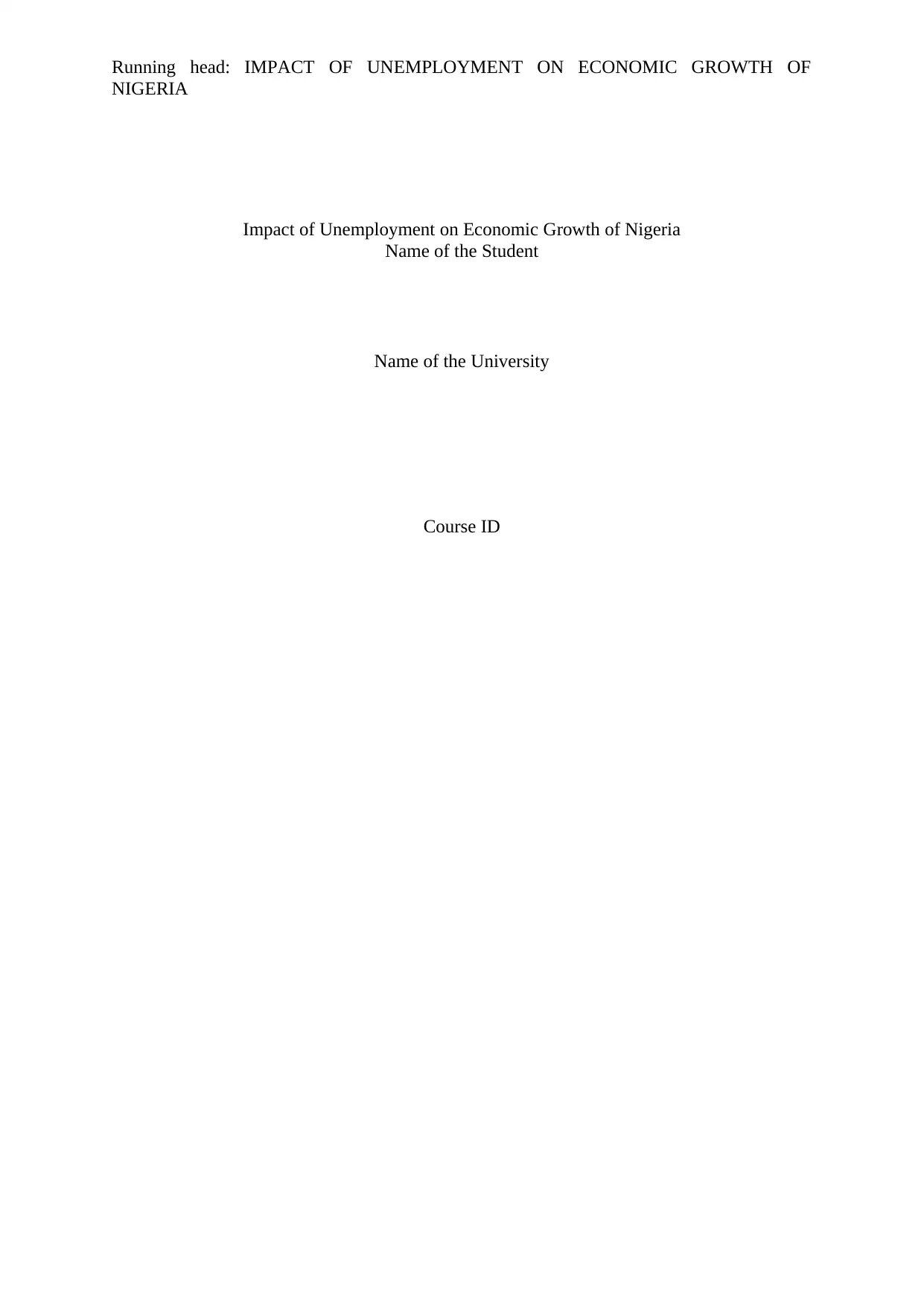
Running head: IMPACT OF UNEMPLOYMENT ON ECONOMIC GROWTH OF
NIGERIA
Impact of Unemployment on Economic Growth of Nigeria
Name of the Student
Name of the University
Course ID
NIGERIA
Impact of Unemployment on Economic Growth of Nigeria
Name of the Student
Name of the University
Course ID
Secure Best Marks with AI Grader
Need help grading? Try our AI Grader for instant feedback on your assignments.
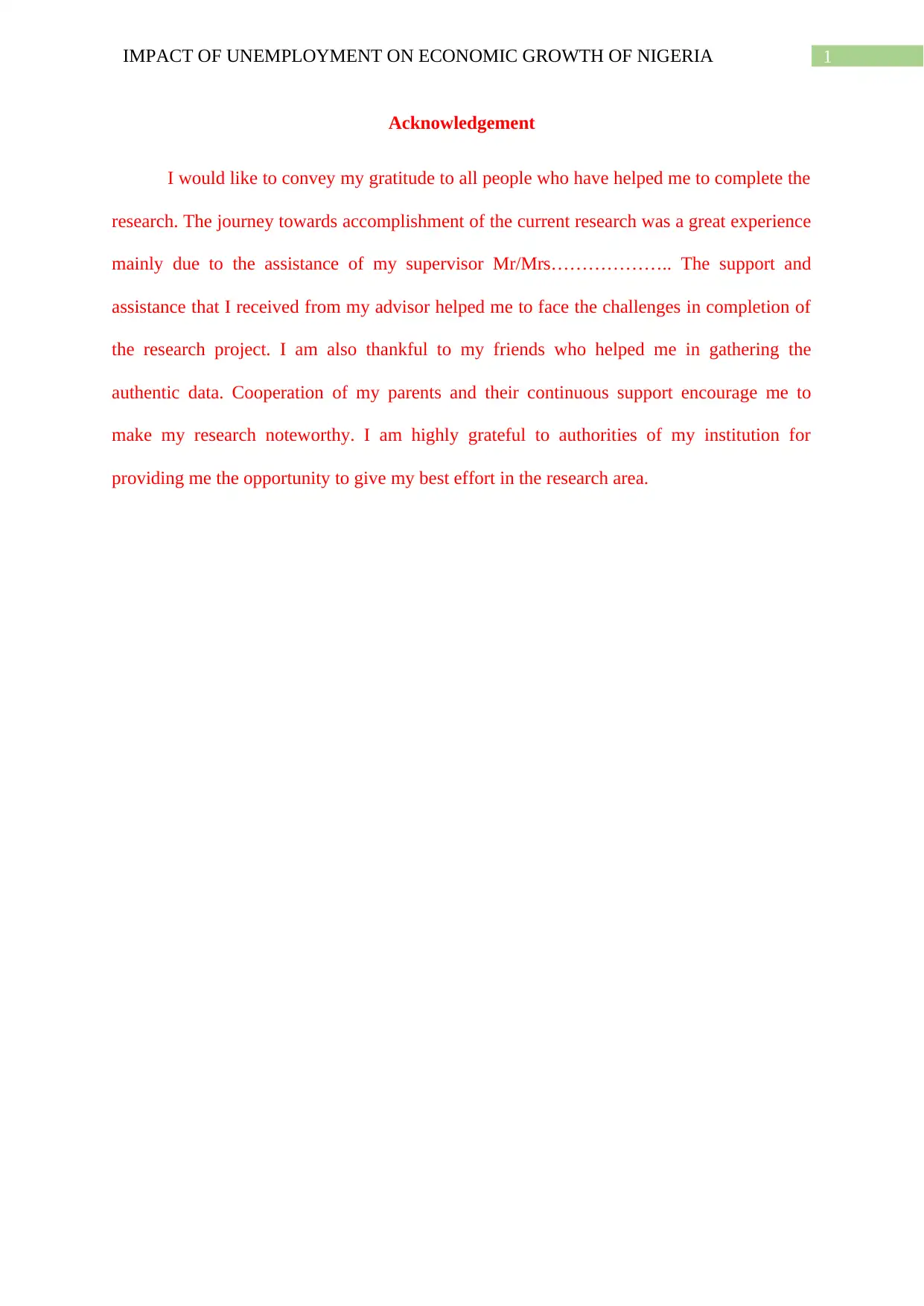
1IMPACT OF UNEMPLOYMENT ON ECONOMIC GROWTH OF NIGERIA
Acknowledgement
I would like to convey my gratitude to all people who have helped me to complete the
research. The journey towards accomplishment of the current research was a great experience
mainly due to the assistance of my supervisor Mr/Mrs……………….. The support and
assistance that I received from my advisor helped me to face the challenges in completion of
the research project. I am also thankful to my friends who helped me in gathering the
authentic data. Cooperation of my parents and their continuous support encourage me to
make my research noteworthy. I am highly grateful to authorities of my institution for
providing me the opportunity to give my best effort in the research area.
Acknowledgement
I would like to convey my gratitude to all people who have helped me to complete the
research. The journey towards accomplishment of the current research was a great experience
mainly due to the assistance of my supervisor Mr/Mrs……………….. The support and
assistance that I received from my advisor helped me to face the challenges in completion of
the research project. I am also thankful to my friends who helped me in gathering the
authentic data. Cooperation of my parents and their continuous support encourage me to
make my research noteworthy. I am highly grateful to authorities of my institution for
providing me the opportunity to give my best effort in the research area.
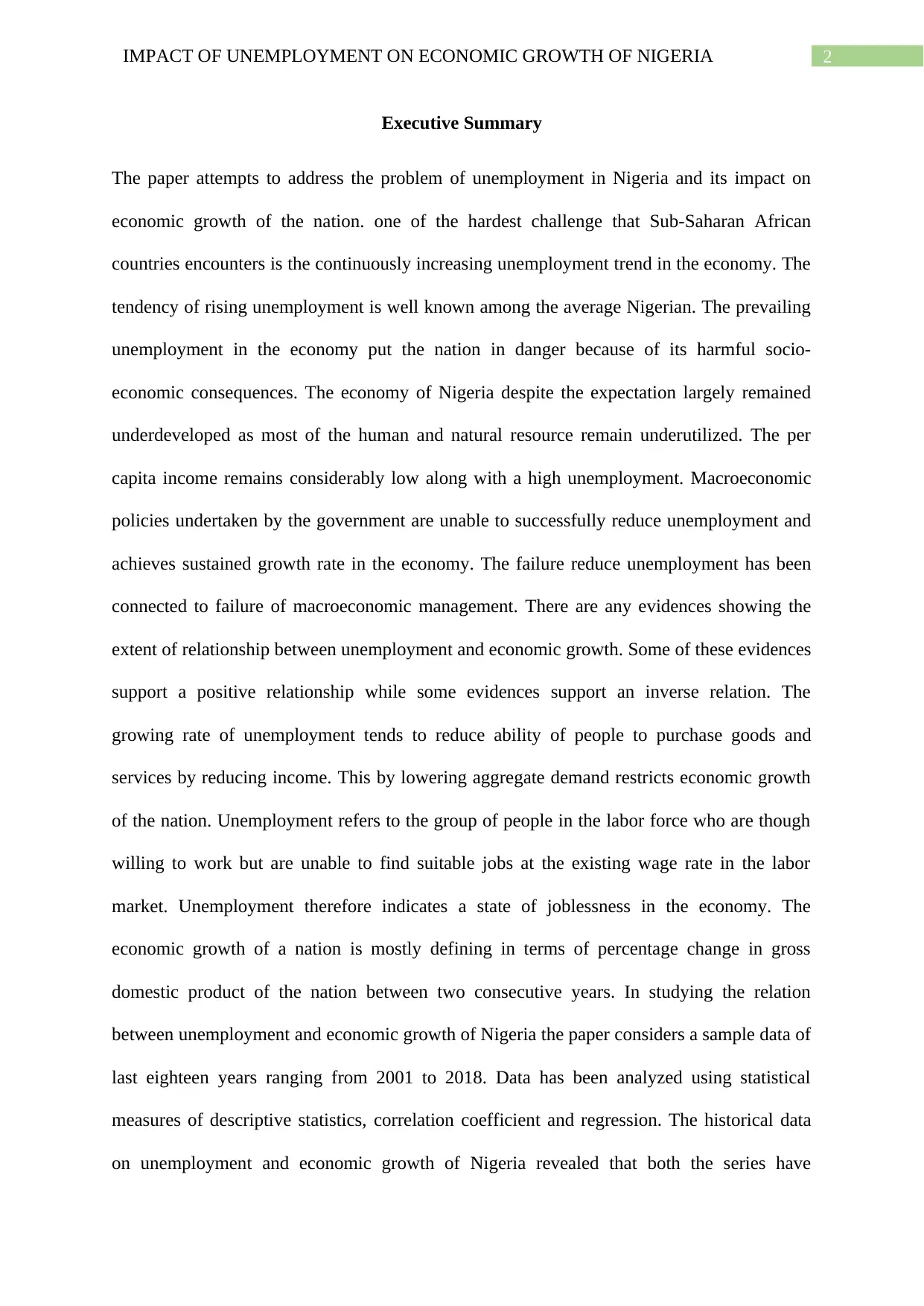
2IMPACT OF UNEMPLOYMENT ON ECONOMIC GROWTH OF NIGERIA
Executive Summary
The paper attempts to address the problem of unemployment in Nigeria and its impact on
economic growth of the nation. one of the hardest challenge that Sub-Saharan African
countries encounters is the continuously increasing unemployment trend in the economy. The
tendency of rising unemployment is well known among the average Nigerian. The prevailing
unemployment in the economy put the nation in danger because of its harmful socio-
economic consequences. The economy of Nigeria despite the expectation largely remained
underdeveloped as most of the human and natural resource remain underutilized. The per
capita income remains considerably low along with a high unemployment. Macroeconomic
policies undertaken by the government are unable to successfully reduce unemployment and
achieves sustained growth rate in the economy. The failure reduce unemployment has been
connected to failure of macroeconomic management. There are any evidences showing the
extent of relationship between unemployment and economic growth. Some of these evidences
support a positive relationship while some evidences support an inverse relation. The
growing rate of unemployment tends to reduce ability of people to purchase goods and
services by reducing income. This by lowering aggregate demand restricts economic growth
of the nation. Unemployment refers to the group of people in the labor force who are though
willing to work but are unable to find suitable jobs at the existing wage rate in the labor
market. Unemployment therefore indicates a state of joblessness in the economy. The
economic growth of a nation is mostly defining in terms of percentage change in gross
domestic product of the nation between two consecutive years. In studying the relation
between unemployment and economic growth of Nigeria the paper considers a sample data of
last eighteen years ranging from 2001 to 2018. Data has been analyzed using statistical
measures of descriptive statistics, correlation coefficient and regression. The historical data
on unemployment and economic growth of Nigeria revealed that both the series have
Executive Summary
The paper attempts to address the problem of unemployment in Nigeria and its impact on
economic growth of the nation. one of the hardest challenge that Sub-Saharan African
countries encounters is the continuously increasing unemployment trend in the economy. The
tendency of rising unemployment is well known among the average Nigerian. The prevailing
unemployment in the economy put the nation in danger because of its harmful socio-
economic consequences. The economy of Nigeria despite the expectation largely remained
underdeveloped as most of the human and natural resource remain underutilized. The per
capita income remains considerably low along with a high unemployment. Macroeconomic
policies undertaken by the government are unable to successfully reduce unemployment and
achieves sustained growth rate in the economy. The failure reduce unemployment has been
connected to failure of macroeconomic management. There are any evidences showing the
extent of relationship between unemployment and economic growth. Some of these evidences
support a positive relationship while some evidences support an inverse relation. The
growing rate of unemployment tends to reduce ability of people to purchase goods and
services by reducing income. This by lowering aggregate demand restricts economic growth
of the nation. Unemployment refers to the group of people in the labor force who are though
willing to work but are unable to find suitable jobs at the existing wage rate in the labor
market. Unemployment therefore indicates a state of joblessness in the economy. The
economic growth of a nation is mostly defining in terms of percentage change in gross
domestic product of the nation between two consecutive years. In studying the relation
between unemployment and economic growth of Nigeria the paper considers a sample data of
last eighteen years ranging from 2001 to 2018. Data has been analyzed using statistical
measures of descriptive statistics, correlation coefficient and regression. The historical data
on unemployment and economic growth of Nigeria revealed that both the series have
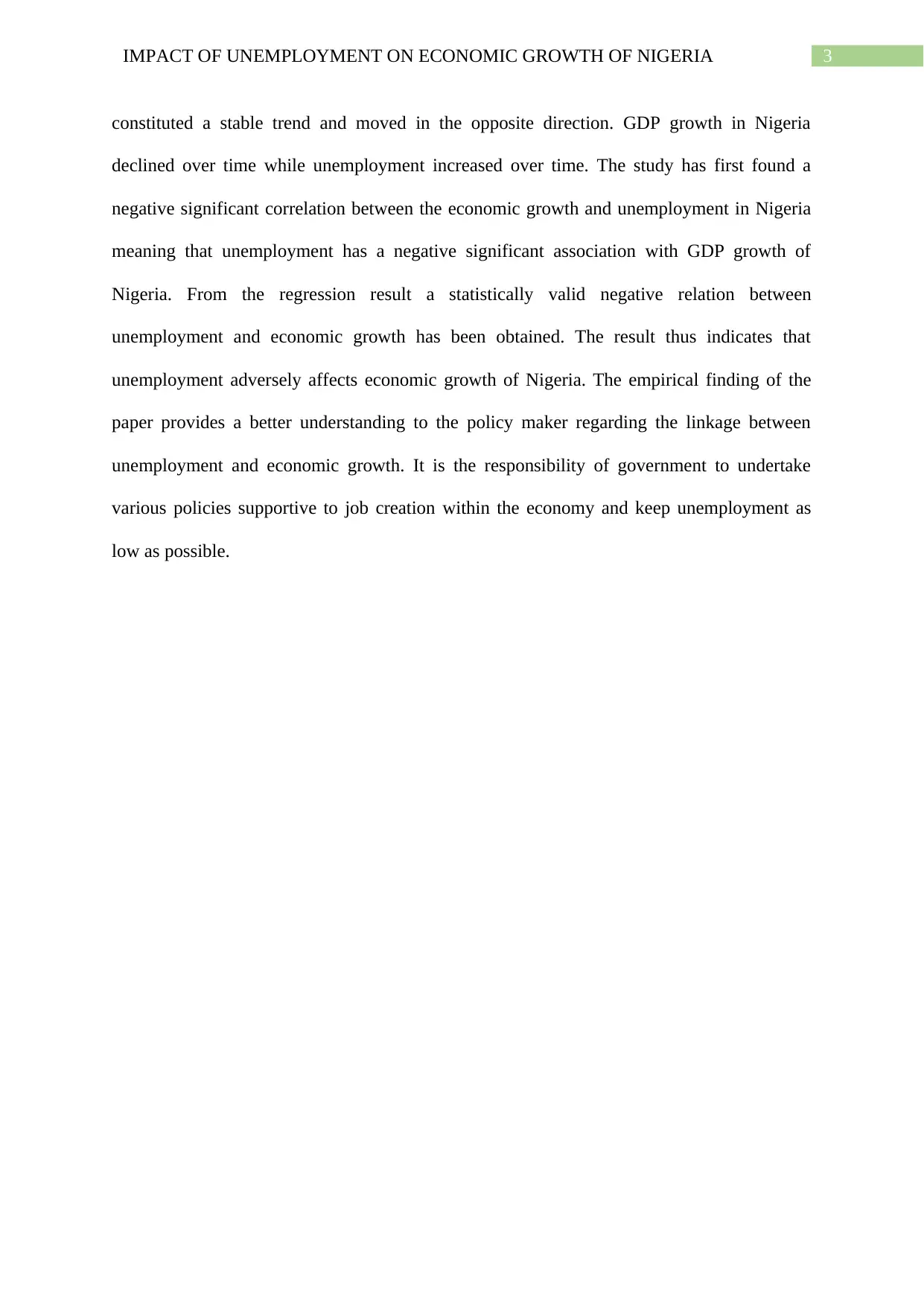
3IMPACT OF UNEMPLOYMENT ON ECONOMIC GROWTH OF NIGERIA
constituted a stable trend and moved in the opposite direction. GDP growth in Nigeria
declined over time while unemployment increased over time. The study has first found a
negative significant correlation between the economic growth and unemployment in Nigeria
meaning that unemployment has a negative significant association with GDP growth of
Nigeria. From the regression result a statistically valid negative relation between
unemployment and economic growth has been obtained. The result thus indicates that
unemployment adversely affects economic growth of Nigeria. The empirical finding of the
paper provides a better understanding to the policy maker regarding the linkage between
unemployment and economic growth. It is the responsibility of government to undertake
various policies supportive to job creation within the economy and keep unemployment as
low as possible.
constituted a stable trend and moved in the opposite direction. GDP growth in Nigeria
declined over time while unemployment increased over time. The study has first found a
negative significant correlation between the economic growth and unemployment in Nigeria
meaning that unemployment has a negative significant association with GDP growth of
Nigeria. From the regression result a statistically valid negative relation between
unemployment and economic growth has been obtained. The result thus indicates that
unemployment adversely affects economic growth of Nigeria. The empirical finding of the
paper provides a better understanding to the policy maker regarding the linkage between
unemployment and economic growth. It is the responsibility of government to undertake
various policies supportive to job creation within the economy and keep unemployment as
low as possible.
Secure Best Marks with AI Grader
Need help grading? Try our AI Grader for instant feedback on your assignments.
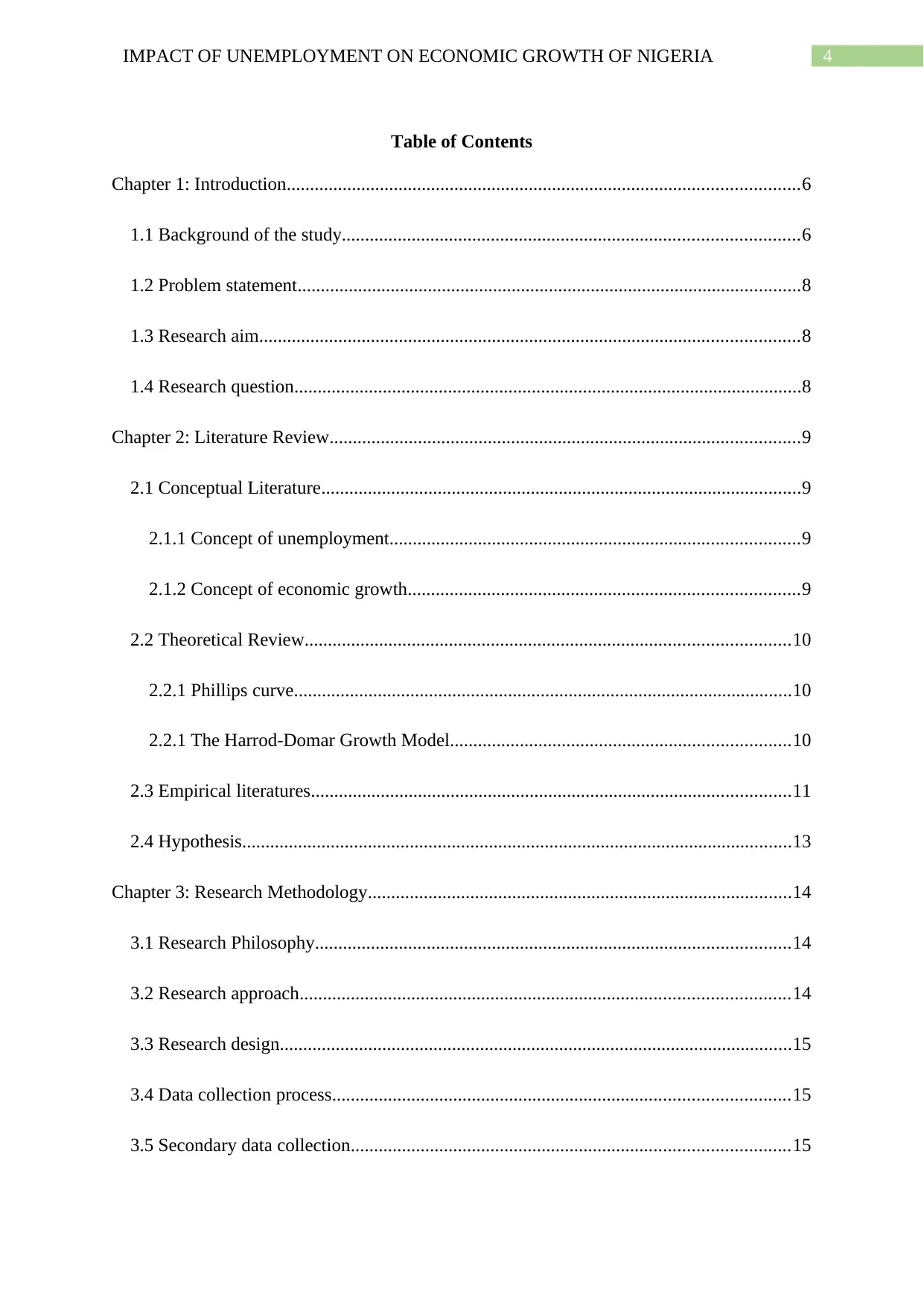
4IMPACT OF UNEMPLOYMENT ON ECONOMIC GROWTH OF NIGERIA
Table of Contents
Chapter 1: Introduction..............................................................................................................6
1.1 Background of the study..................................................................................................6
1.2 Problem statement............................................................................................................8
1.3 Research aim....................................................................................................................8
1.4 Research question.............................................................................................................8
Chapter 2: Literature Review.....................................................................................................9
2.1 Conceptual Literature.......................................................................................................9
2.1.1 Concept of unemployment........................................................................................9
2.1.2 Concept of economic growth....................................................................................9
2.2 Theoretical Review........................................................................................................10
2.2.1 Phillips curve...........................................................................................................10
2.2.1 The Harrod-Domar Growth Model.........................................................................10
2.3 Empirical literatures.......................................................................................................11
2.4 Hypothesis......................................................................................................................13
Chapter 3: Research Methodology...........................................................................................14
3.1 Research Philosophy......................................................................................................14
3.2 Research approach.........................................................................................................14
3.3 Research design..............................................................................................................15
3.4 Data collection process..................................................................................................15
3.5 Secondary data collection..............................................................................................15
Table of Contents
Chapter 1: Introduction..............................................................................................................6
1.1 Background of the study..................................................................................................6
1.2 Problem statement............................................................................................................8
1.3 Research aim....................................................................................................................8
1.4 Research question.............................................................................................................8
Chapter 2: Literature Review.....................................................................................................9
2.1 Conceptual Literature.......................................................................................................9
2.1.1 Concept of unemployment........................................................................................9
2.1.2 Concept of economic growth....................................................................................9
2.2 Theoretical Review........................................................................................................10
2.2.1 Phillips curve...........................................................................................................10
2.2.1 The Harrod-Domar Growth Model.........................................................................10
2.3 Empirical literatures.......................................................................................................11
2.4 Hypothesis......................................................................................................................13
Chapter 3: Research Methodology...........................................................................................14
3.1 Research Philosophy......................................................................................................14
3.2 Research approach.........................................................................................................14
3.3 Research design..............................................................................................................15
3.4 Data collection process..................................................................................................15
3.5 Secondary data collection..............................................................................................15
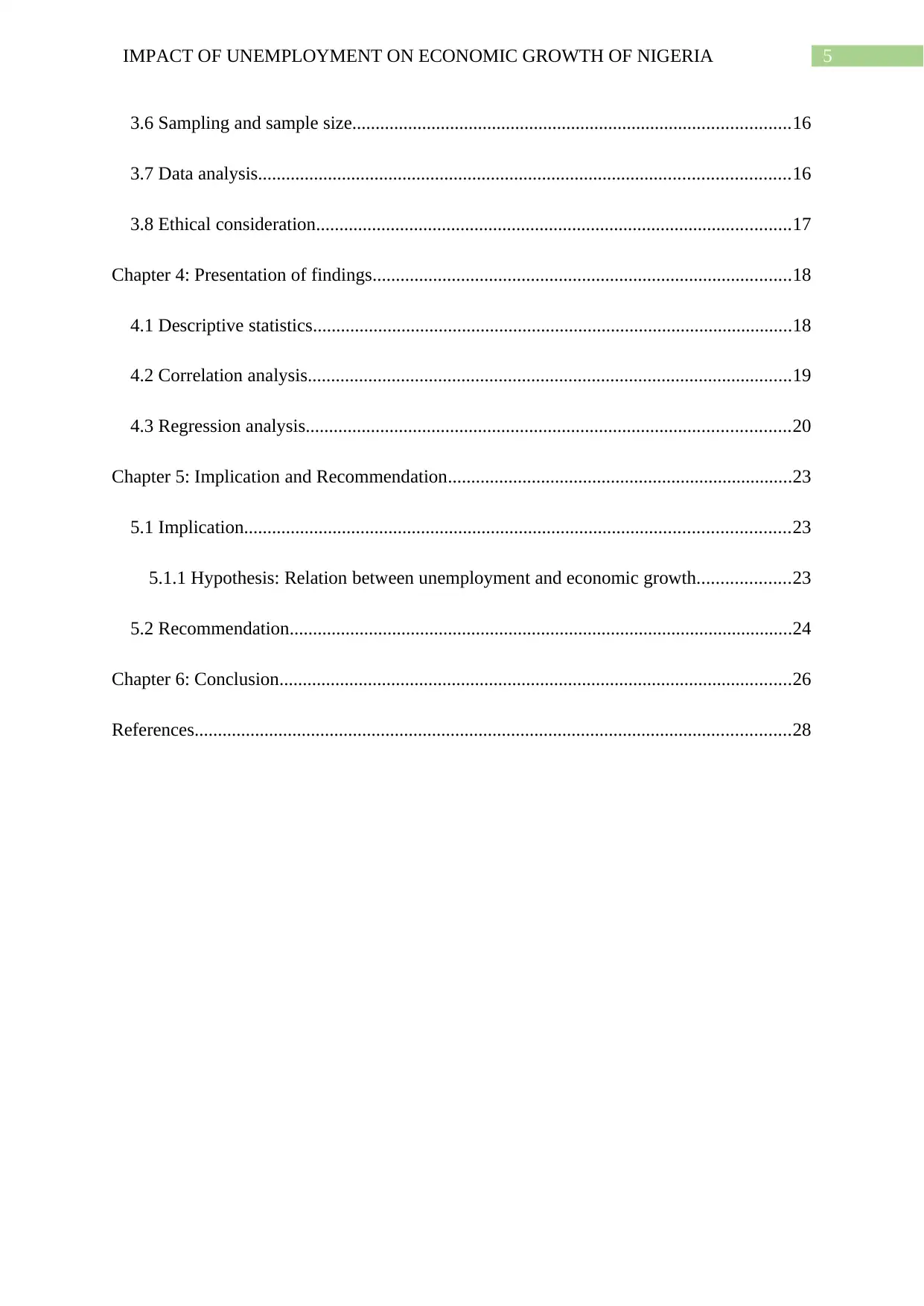
5IMPACT OF UNEMPLOYMENT ON ECONOMIC GROWTH OF NIGERIA
3.6 Sampling and sample size..............................................................................................16
3.7 Data analysis..................................................................................................................16
3.8 Ethical consideration......................................................................................................17
Chapter 4: Presentation of findings..........................................................................................18
4.1 Descriptive statistics.......................................................................................................18
4.2 Correlation analysis........................................................................................................19
4.3 Regression analysis........................................................................................................20
Chapter 5: Implication and Recommendation..........................................................................23
5.1 Implication.....................................................................................................................23
5.1.1 Hypothesis: Relation between unemployment and economic growth....................23
5.2 Recommendation............................................................................................................24
Chapter 6: Conclusion..............................................................................................................26
References................................................................................................................................28
3.6 Sampling and sample size..............................................................................................16
3.7 Data analysis..................................................................................................................16
3.8 Ethical consideration......................................................................................................17
Chapter 4: Presentation of findings..........................................................................................18
4.1 Descriptive statistics.......................................................................................................18
4.2 Correlation analysis........................................................................................................19
4.3 Regression analysis........................................................................................................20
Chapter 5: Implication and Recommendation..........................................................................23
5.1 Implication.....................................................................................................................23
5.1.1 Hypothesis: Relation between unemployment and economic growth....................23
5.2 Recommendation............................................................................................................24
Chapter 6: Conclusion..............................................................................................................26
References................................................................................................................................28

6IMPACT OF UNEMPLOYMENT ON ECONOMIC GROWTH OF NIGERIA
Chapter 1: Introduction
1.1 Background of the study
Unemployment is considered as one serious problem that most developing and
developed nations face. Unemployment results in various socio-economic problem in a
nation. Now a day, one of the hardest challenge that Sub-Saharan African countries
encounters is the continuously increasing unemployment trend in the economy (Olotu, Salami
and Akeremale 2015). The tendency of rising unemployment is well known among the
average Nigerian. The unemployment rate in Nigeria according to the published report in
2012 was 23.9 percent. The rate of unemployment among the youth people was 20.3 million.
In the group of youth unemployment 4.5 million were new entrants, 2.2 million were just
completed their primary school and had not gone for higher secondary studies and 1 million
were completed their secondary education but had not gone for further studies at the tertiary
level (Seth, John and Dalhatu 2018). The prevailing unemployment in the economy put the
nation in danger because of its harmful socio-economic consequences.
In reducing unemployment, economic growth rate is considered as one key variable
that address the problem. In economic development of a nation, economic growth plays an
important role (Oduwole 2015). Economic growth is regarded as an important instrument
through which unemployment can possibly be reduced, price level can be stabilized,
innovation can be encouraged and the target of poverty alleviation can be achieved.
Economic growth offers entrepreneurs the necessary platform to expand activities which in
turn reduces unemployment by creating new jobs (Okoye 2017). Considering all these facts,
it can be said that unemployment rate is likely to reduce as a result of economic growth.
The economy of Nigeria despite the expectation largely remained underdeveloped as
most of the human and natural resource remain underutilized. The per capita income remains
considerably low along with a high unemployment. Macroeconomic policies undertaken by
Chapter 1: Introduction
1.1 Background of the study
Unemployment is considered as one serious problem that most developing and
developed nations face. Unemployment results in various socio-economic problem in a
nation. Now a day, one of the hardest challenge that Sub-Saharan African countries
encounters is the continuously increasing unemployment trend in the economy (Olotu, Salami
and Akeremale 2015). The tendency of rising unemployment is well known among the
average Nigerian. The unemployment rate in Nigeria according to the published report in
2012 was 23.9 percent. The rate of unemployment among the youth people was 20.3 million.
In the group of youth unemployment 4.5 million were new entrants, 2.2 million were just
completed their primary school and had not gone for higher secondary studies and 1 million
were completed their secondary education but had not gone for further studies at the tertiary
level (Seth, John and Dalhatu 2018). The prevailing unemployment in the economy put the
nation in danger because of its harmful socio-economic consequences.
In reducing unemployment, economic growth rate is considered as one key variable
that address the problem. In economic development of a nation, economic growth plays an
important role (Oduwole 2015). Economic growth is regarded as an important instrument
through which unemployment can possibly be reduced, price level can be stabilized,
innovation can be encouraged and the target of poverty alleviation can be achieved.
Economic growth offers entrepreneurs the necessary platform to expand activities which in
turn reduces unemployment by creating new jobs (Okoye 2017). Considering all these facts,
it can be said that unemployment rate is likely to reduce as a result of economic growth.
The economy of Nigeria despite the expectation largely remained underdeveloped as
most of the human and natural resource remain underutilized. The per capita income remains
considerably low along with a high unemployment. Macroeconomic policies undertaken by
Paraphrase This Document
Need a fresh take? Get an instant paraphrase of this document with our AI Paraphraser
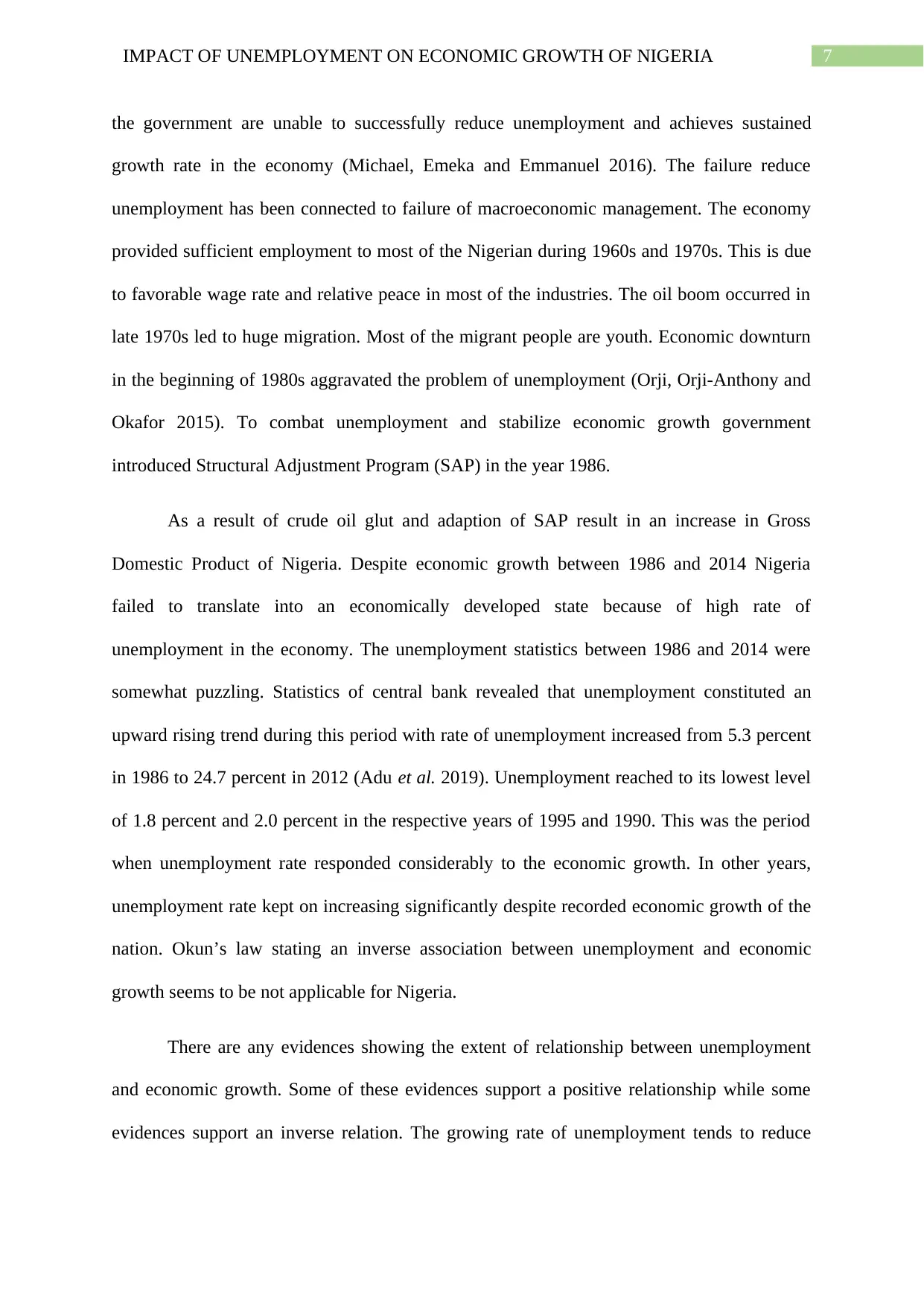
7IMPACT OF UNEMPLOYMENT ON ECONOMIC GROWTH OF NIGERIA
the government are unable to successfully reduce unemployment and achieves sustained
growth rate in the economy (Michael, Emeka and Emmanuel 2016). The failure reduce
unemployment has been connected to failure of macroeconomic management. The economy
provided sufficient employment to most of the Nigerian during 1960s and 1970s. This is due
to favorable wage rate and relative peace in most of the industries. The oil boom occurred in
late 1970s led to huge migration. Most of the migrant people are youth. Economic downturn
in the beginning of 1980s aggravated the problem of unemployment (Orji, Orji-Anthony and
Okafor 2015). To combat unemployment and stabilize economic growth government
introduced Structural Adjustment Program (SAP) in the year 1986.
As a result of crude oil glut and adaption of SAP result in an increase in Gross
Domestic Product of Nigeria. Despite economic growth between 1986 and 2014 Nigeria
failed to translate into an economically developed state because of high rate of
unemployment in the economy. The unemployment statistics between 1986 and 2014 were
somewhat puzzling. Statistics of central bank revealed that unemployment constituted an
upward rising trend during this period with rate of unemployment increased from 5.3 percent
in 1986 to 24.7 percent in 2012 (Adu et al. 2019). Unemployment reached to its lowest level
of 1.8 percent and 2.0 percent in the respective years of 1995 and 1990. This was the period
when unemployment rate responded considerably to the economic growth. In other years,
unemployment rate kept on increasing significantly despite recorded economic growth of the
nation. Okun’s law stating an inverse association between unemployment and economic
growth seems to be not applicable for Nigeria.
There are any evidences showing the extent of relationship between unemployment
and economic growth. Some of these evidences support a positive relationship while some
evidences support an inverse relation. The growing rate of unemployment tends to reduce
the government are unable to successfully reduce unemployment and achieves sustained
growth rate in the economy (Michael, Emeka and Emmanuel 2016). The failure reduce
unemployment has been connected to failure of macroeconomic management. The economy
provided sufficient employment to most of the Nigerian during 1960s and 1970s. This is due
to favorable wage rate and relative peace in most of the industries. The oil boom occurred in
late 1970s led to huge migration. Most of the migrant people are youth. Economic downturn
in the beginning of 1980s aggravated the problem of unemployment (Orji, Orji-Anthony and
Okafor 2015). To combat unemployment and stabilize economic growth government
introduced Structural Adjustment Program (SAP) in the year 1986.
As a result of crude oil glut and adaption of SAP result in an increase in Gross
Domestic Product of Nigeria. Despite economic growth between 1986 and 2014 Nigeria
failed to translate into an economically developed state because of high rate of
unemployment in the economy. The unemployment statistics between 1986 and 2014 were
somewhat puzzling. Statistics of central bank revealed that unemployment constituted an
upward rising trend during this period with rate of unemployment increased from 5.3 percent
in 1986 to 24.7 percent in 2012 (Adu et al. 2019). Unemployment reached to its lowest level
of 1.8 percent and 2.0 percent in the respective years of 1995 and 1990. This was the period
when unemployment rate responded considerably to the economic growth. In other years,
unemployment rate kept on increasing significantly despite recorded economic growth of the
nation. Okun’s law stating an inverse association between unemployment and economic
growth seems to be not applicable for Nigeria.
There are any evidences showing the extent of relationship between unemployment
and economic growth. Some of these evidences support a positive relationship while some
evidences support an inverse relation. The growing rate of unemployment tends to reduce
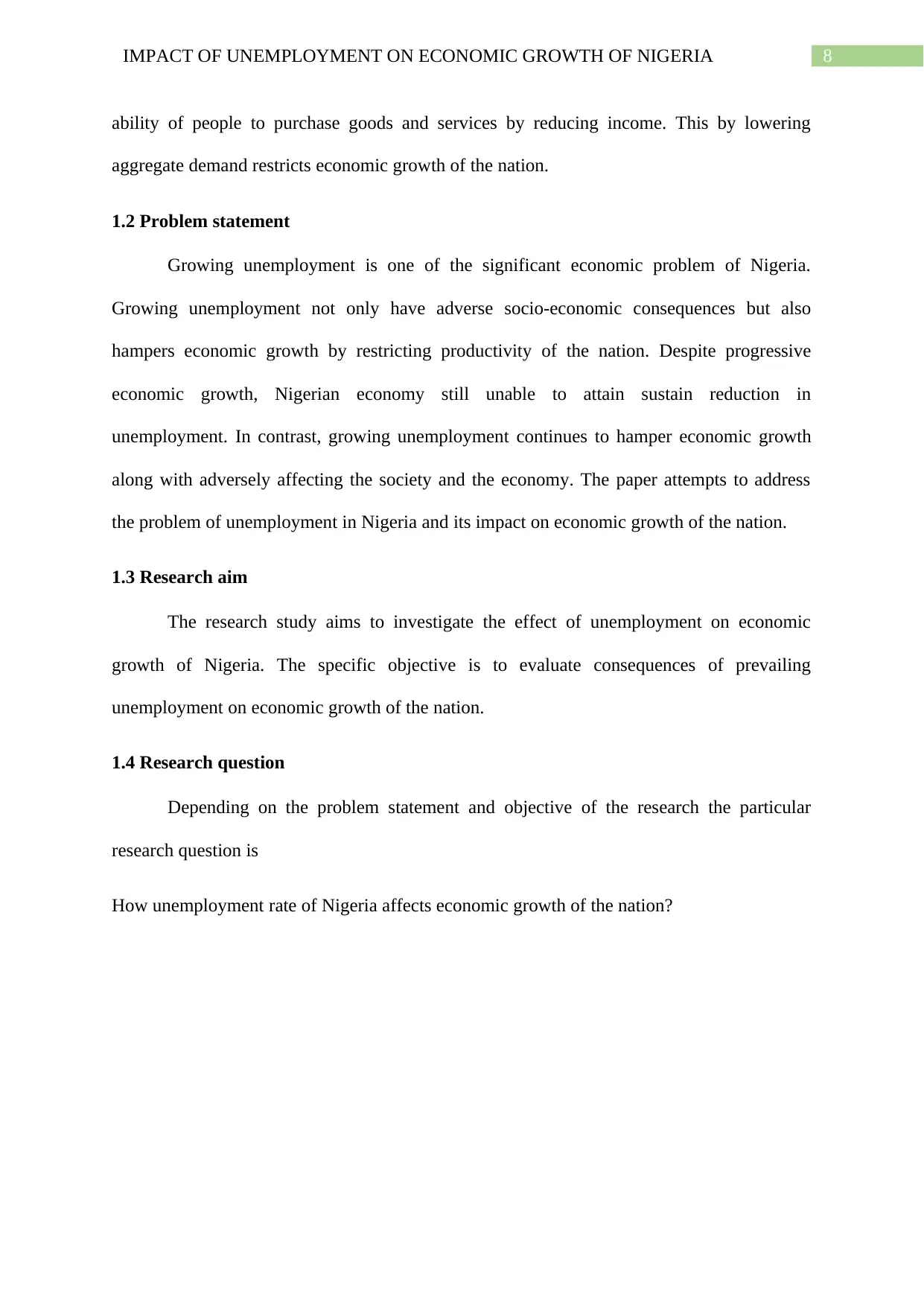
8IMPACT OF UNEMPLOYMENT ON ECONOMIC GROWTH OF NIGERIA
ability of people to purchase goods and services by reducing income. This by lowering
aggregate demand restricts economic growth of the nation.
1.2 Problem statement
Growing unemployment is one of the significant economic problem of Nigeria.
Growing unemployment not only have adverse socio-economic consequences but also
hampers economic growth by restricting productivity of the nation. Despite progressive
economic growth, Nigerian economy still unable to attain sustain reduction in
unemployment. In contrast, growing unemployment continues to hamper economic growth
along with adversely affecting the society and the economy. The paper attempts to address
the problem of unemployment in Nigeria and its impact on economic growth of the nation.
1.3 Research aim
The research study aims to investigate the effect of unemployment on economic
growth of Nigeria. The specific objective is to evaluate consequences of prevailing
unemployment on economic growth of the nation.
1.4 Research question
Depending on the problem statement and objective of the research the particular
research question is
How unemployment rate of Nigeria affects economic growth of the nation?
ability of people to purchase goods and services by reducing income. This by lowering
aggregate demand restricts economic growth of the nation.
1.2 Problem statement
Growing unemployment is one of the significant economic problem of Nigeria.
Growing unemployment not only have adverse socio-economic consequences but also
hampers economic growth by restricting productivity of the nation. Despite progressive
economic growth, Nigerian economy still unable to attain sustain reduction in
unemployment. In contrast, growing unemployment continues to hamper economic growth
along with adversely affecting the society and the economy. The paper attempts to address
the problem of unemployment in Nigeria and its impact on economic growth of the nation.
1.3 Research aim
The research study aims to investigate the effect of unemployment on economic
growth of Nigeria. The specific objective is to evaluate consequences of prevailing
unemployment on economic growth of the nation.
1.4 Research question
Depending on the problem statement and objective of the research the particular
research question is
How unemployment rate of Nigeria affects economic growth of the nation?
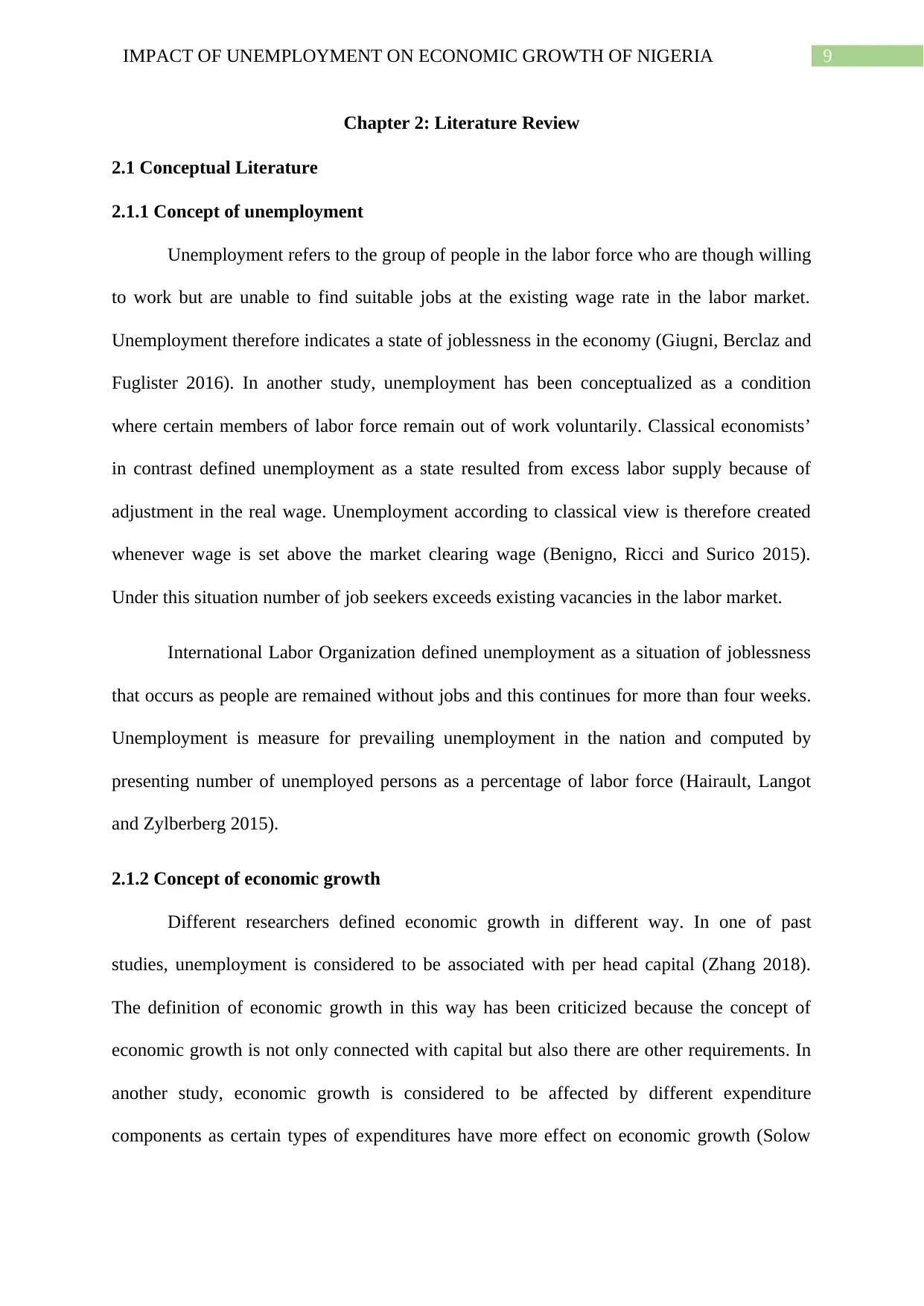
9IMPACT OF UNEMPLOYMENT ON ECONOMIC GROWTH OF NIGERIA
Chapter 2: Literature Review
2.1 Conceptual Literature
2.1.1 Concept of unemployment
Unemployment refers to the group of people in the labor force who are though willing
to work but are unable to find suitable jobs at the existing wage rate in the labor market.
Unemployment therefore indicates a state of joblessness in the economy (Giugni, Berclaz and
Fuglister 2016). In another study, unemployment has been conceptualized as a condition
where certain members of labor force remain out of work voluntarily. Classical economists’
in contrast defined unemployment as a state resulted from excess labor supply because of
adjustment in the real wage. Unemployment according to classical view is therefore created
whenever wage is set above the market clearing wage (Benigno, Ricci and Surico 2015).
Under this situation number of job seekers exceeds existing vacancies in the labor market.
International Labor Organization defined unemployment as a situation of joblessness
that occurs as people are remained without jobs and this continues for more than four weeks.
Unemployment is measure for prevailing unemployment in the nation and computed by
presenting number of unemployed persons as a percentage of labor force (Hairault, Langot
and Zylberberg 2015).
2.1.2 Concept of economic growth
Different researchers defined economic growth in different way. In one of past
studies, unemployment is considered to be associated with per head capital (Zhang 2018).
The definition of economic growth in this way has been criticized because the concept of
economic growth is not only connected with capital but also there are other requirements. In
another study, economic growth is considered to be affected by different expenditure
components as certain types of expenditures have more effect on economic growth (Solow
Chapter 2: Literature Review
2.1 Conceptual Literature
2.1.1 Concept of unemployment
Unemployment refers to the group of people in the labor force who are though willing
to work but are unable to find suitable jobs at the existing wage rate in the labor market.
Unemployment therefore indicates a state of joblessness in the economy (Giugni, Berclaz and
Fuglister 2016). In another study, unemployment has been conceptualized as a condition
where certain members of labor force remain out of work voluntarily. Classical economists’
in contrast defined unemployment as a state resulted from excess labor supply because of
adjustment in the real wage. Unemployment according to classical view is therefore created
whenever wage is set above the market clearing wage (Benigno, Ricci and Surico 2015).
Under this situation number of job seekers exceeds existing vacancies in the labor market.
International Labor Organization defined unemployment as a situation of joblessness
that occurs as people are remained without jobs and this continues for more than four weeks.
Unemployment is measure for prevailing unemployment in the nation and computed by
presenting number of unemployed persons as a percentage of labor force (Hairault, Langot
and Zylberberg 2015).
2.1.2 Concept of economic growth
Different researchers defined economic growth in different way. In one of past
studies, unemployment is considered to be associated with per head capital (Zhang 2018).
The definition of economic growth in this way has been criticized because the concept of
economic growth is not only connected with capital but also there are other requirements. In
another study, economic growth is considered to be affected by different expenditure
components as certain types of expenditures have more effect on economic growth (Solow
Secure Best Marks with AI Grader
Need help grading? Try our AI Grader for instant feedback on your assignments.
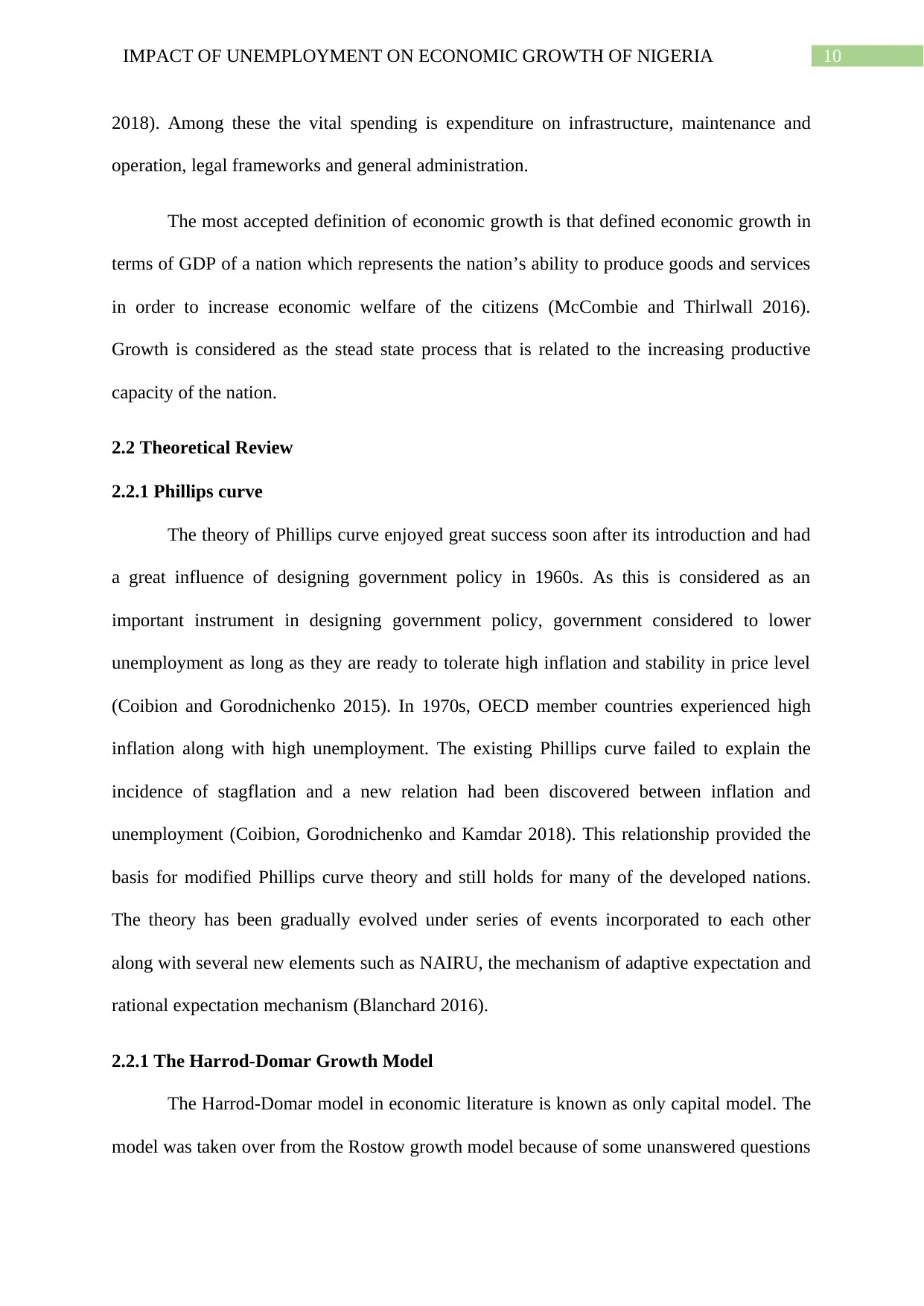
10IMPACT OF UNEMPLOYMENT ON ECONOMIC GROWTH OF NIGERIA
2018). Among these the vital spending is expenditure on infrastructure, maintenance and
operation, legal frameworks and general administration.
The most accepted definition of economic growth is that defined economic growth in
terms of GDP of a nation which represents the nation’s ability to produce goods and services
in order to increase economic welfare of the citizens (McCombie and Thirlwall 2016).
Growth is considered as the stead state process that is related to the increasing productive
capacity of the nation.
2.2 Theoretical Review
2.2.1 Phillips curve
The theory of Phillips curve enjoyed great success soon after its introduction and had
a great influence of designing government policy in 1960s. As this is considered as an
important instrument in designing government policy, government considered to lower
unemployment as long as they are ready to tolerate high inflation and stability in price level
(Coibion and Gorodnichenko 2015). In 1970s, OECD member countries experienced high
inflation along with high unemployment. The existing Phillips curve failed to explain the
incidence of stagflation and a new relation had been discovered between inflation and
unemployment (Coibion, Gorodnichenko and Kamdar 2018). This relationship provided the
basis for modified Phillips curve theory and still holds for many of the developed nations.
The theory has been gradually evolved under series of events incorporated to each other
along with several new elements such as NAIRU, the mechanism of adaptive expectation and
rational expectation mechanism (Blanchard 2016).
2.2.1 The Harrod-Domar Growth Model
The Harrod-Domar model in economic literature is known as only capital model. The
model was taken over from the Rostow growth model because of some unanswered questions
2018). Among these the vital spending is expenditure on infrastructure, maintenance and
operation, legal frameworks and general administration.
The most accepted definition of economic growth is that defined economic growth in
terms of GDP of a nation which represents the nation’s ability to produce goods and services
in order to increase economic welfare of the citizens (McCombie and Thirlwall 2016).
Growth is considered as the stead state process that is related to the increasing productive
capacity of the nation.
2.2 Theoretical Review
2.2.1 Phillips curve
The theory of Phillips curve enjoyed great success soon after its introduction and had
a great influence of designing government policy in 1960s. As this is considered as an
important instrument in designing government policy, government considered to lower
unemployment as long as they are ready to tolerate high inflation and stability in price level
(Coibion and Gorodnichenko 2015). In 1970s, OECD member countries experienced high
inflation along with high unemployment. The existing Phillips curve failed to explain the
incidence of stagflation and a new relation had been discovered between inflation and
unemployment (Coibion, Gorodnichenko and Kamdar 2018). This relationship provided the
basis for modified Phillips curve theory and still holds for many of the developed nations.
The theory has been gradually evolved under series of events incorporated to each other
along with several new elements such as NAIRU, the mechanism of adaptive expectation and
rational expectation mechanism (Blanchard 2016).
2.2.1 The Harrod-Domar Growth Model
The Harrod-Domar model in economic literature is known as only capital model. The
model was taken over from the Rostow growth model because of some unanswered questions
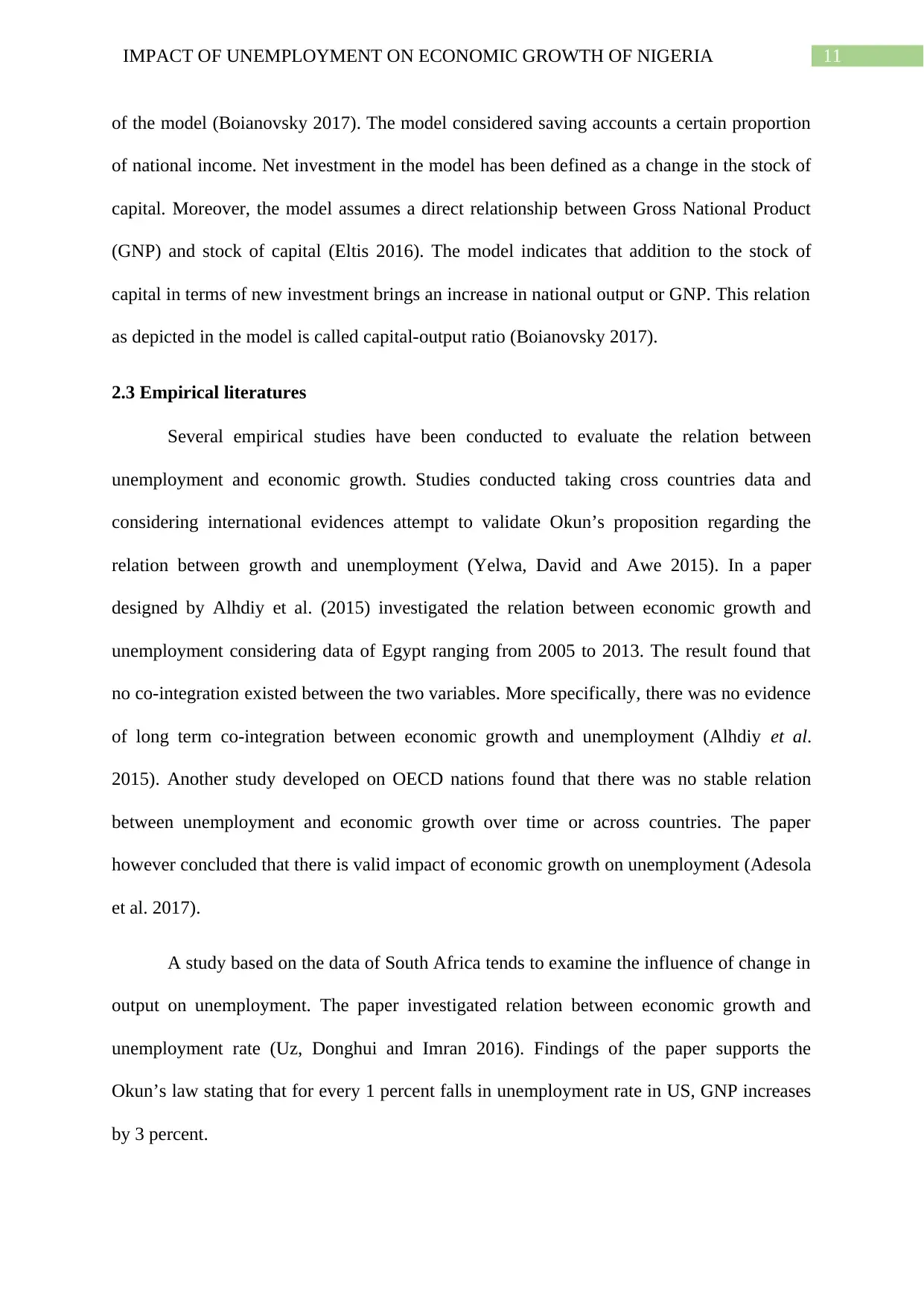
11IMPACT OF UNEMPLOYMENT ON ECONOMIC GROWTH OF NIGERIA
of the model (Boianovsky 2017). The model considered saving accounts a certain proportion
of national income. Net investment in the model has been defined as a change in the stock of
capital. Moreover, the model assumes a direct relationship between Gross National Product
(GNP) and stock of capital (Eltis 2016). The model indicates that addition to the stock of
capital in terms of new investment brings an increase in national output or GNP. This relation
as depicted in the model is called capital-output ratio (Boianovsky 2017).
2.3 Empirical literatures
Several empirical studies have been conducted to evaluate the relation between
unemployment and economic growth. Studies conducted taking cross countries data and
considering international evidences attempt to validate Okun’s proposition regarding the
relation between growth and unemployment (Yelwa, David and Awe 2015). In a paper
designed by Alhdiy et al. (2015) investigated the relation between economic growth and
unemployment considering data of Egypt ranging from 2005 to 2013. The result found that
no co-integration existed between the two variables. More specifically, there was no evidence
of long term co-integration between economic growth and unemployment (Alhdiy et al.
2015). Another study developed on OECD nations found that there was no stable relation
between unemployment and economic growth over time or across countries. The paper
however concluded that there is valid impact of economic growth on unemployment (Adesola
et al. 2017).
A study based on the data of South Africa tends to examine the influence of change in
output on unemployment. The paper investigated relation between economic growth and
unemployment rate (Uz, Donghui and Imran 2016). Findings of the paper supports the
Okun’s law stating that for every 1 percent falls in unemployment rate in US, GNP increases
by 3 percent.
of the model (Boianovsky 2017). The model considered saving accounts a certain proportion
of national income. Net investment in the model has been defined as a change in the stock of
capital. Moreover, the model assumes a direct relationship between Gross National Product
(GNP) and stock of capital (Eltis 2016). The model indicates that addition to the stock of
capital in terms of new investment brings an increase in national output or GNP. This relation
as depicted in the model is called capital-output ratio (Boianovsky 2017).
2.3 Empirical literatures
Several empirical studies have been conducted to evaluate the relation between
unemployment and economic growth. Studies conducted taking cross countries data and
considering international evidences attempt to validate Okun’s proposition regarding the
relation between growth and unemployment (Yelwa, David and Awe 2015). In a paper
designed by Alhdiy et al. (2015) investigated the relation between economic growth and
unemployment considering data of Egypt ranging from 2005 to 2013. The result found that
no co-integration existed between the two variables. More specifically, there was no evidence
of long term co-integration between economic growth and unemployment (Alhdiy et al.
2015). Another study developed on OECD nations found that there was no stable relation
between unemployment and economic growth over time or across countries. The paper
however concluded that there is valid impact of economic growth on unemployment (Adesola
et al. 2017).
A study based on the data of South Africa tends to examine the influence of change in
output on unemployment. The paper investigated relation between economic growth and
unemployment rate (Uz, Donghui and Imran 2016). Findings of the paper supports the
Okun’s law stating that for every 1 percent falls in unemployment rate in US, GNP increases
by 3 percent.
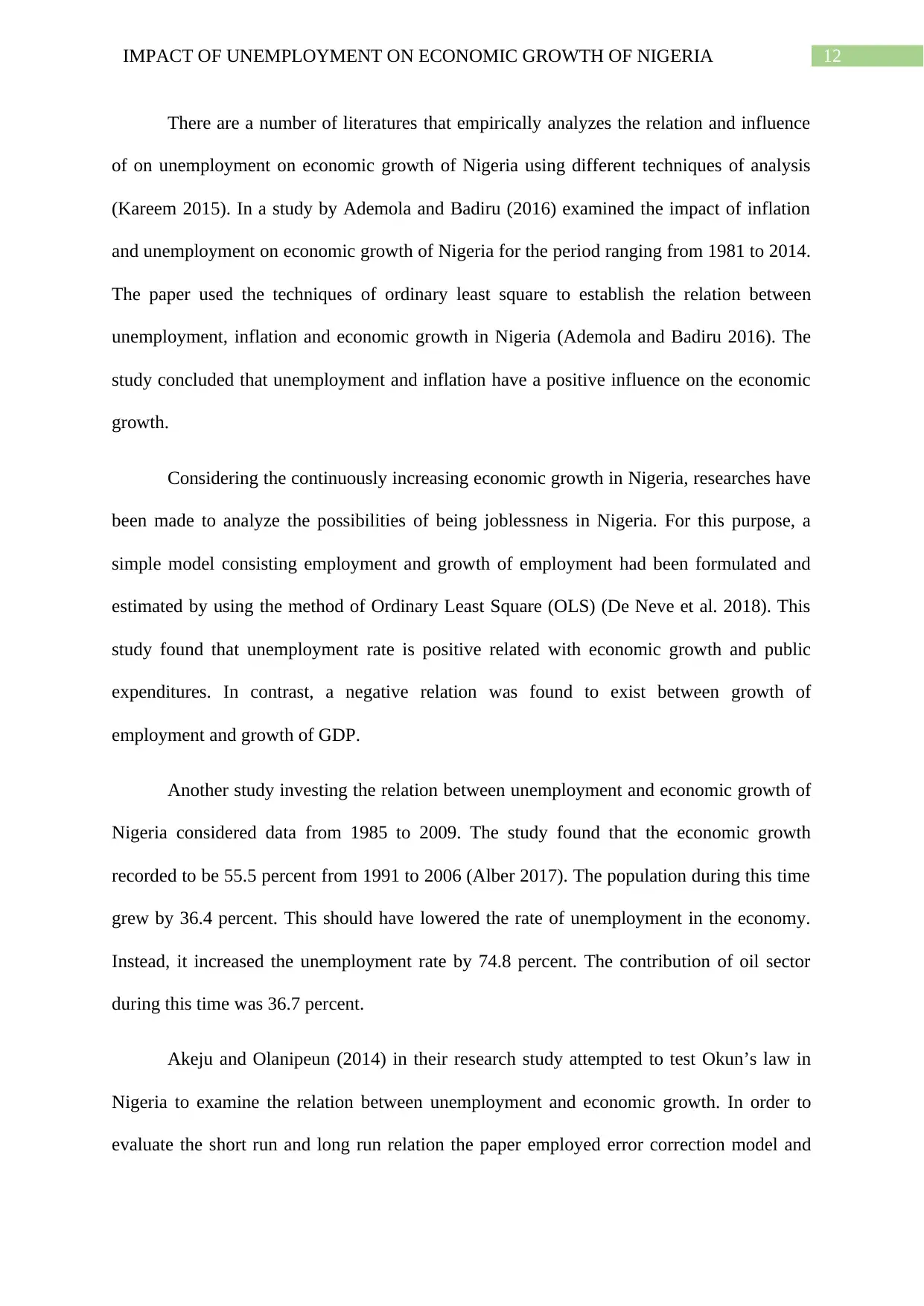
12IMPACT OF UNEMPLOYMENT ON ECONOMIC GROWTH OF NIGERIA
There are a number of literatures that empirically analyzes the relation and influence
of on unemployment on economic growth of Nigeria using different techniques of analysis
(Kareem 2015). In a study by Ademola and Badiru (2016) examined the impact of inflation
and unemployment on economic growth of Nigeria for the period ranging from 1981 to 2014.
The paper used the techniques of ordinary least square to establish the relation between
unemployment, inflation and economic growth in Nigeria (Ademola and Badiru 2016). The
study concluded that unemployment and inflation have a positive influence on the economic
growth.
Considering the continuously increasing economic growth in Nigeria, researches have
been made to analyze the possibilities of being joblessness in Nigeria. For this purpose, a
simple model consisting employment and growth of employment had been formulated and
estimated by using the method of Ordinary Least Square (OLS) (De Neve et al. 2018). This
study found that unemployment rate is positive related with economic growth and public
expenditures. In contrast, a negative relation was found to exist between growth of
employment and growth of GDP.
Another study investing the relation between unemployment and economic growth of
Nigeria considered data from 1985 to 2009. The study found that the economic growth
recorded to be 55.5 percent from 1991 to 2006 (Alber 2017). The population during this time
grew by 36.4 percent. This should have lowered the rate of unemployment in the economy.
Instead, it increased the unemployment rate by 74.8 percent. The contribution of oil sector
during this time was 36.7 percent.
Akeju and Olanipeun (2014) in their research study attempted to test Okun’s law in
Nigeria to examine the relation between unemployment and economic growth. In order to
evaluate the short run and long run relation the paper employed error correction model and
There are a number of literatures that empirically analyzes the relation and influence
of on unemployment on economic growth of Nigeria using different techniques of analysis
(Kareem 2015). In a study by Ademola and Badiru (2016) examined the impact of inflation
and unemployment on economic growth of Nigeria for the period ranging from 1981 to 2014.
The paper used the techniques of ordinary least square to establish the relation between
unemployment, inflation and economic growth in Nigeria (Ademola and Badiru 2016). The
study concluded that unemployment and inflation have a positive influence on the economic
growth.
Considering the continuously increasing economic growth in Nigeria, researches have
been made to analyze the possibilities of being joblessness in Nigeria. For this purpose, a
simple model consisting employment and growth of employment had been formulated and
estimated by using the method of Ordinary Least Square (OLS) (De Neve et al. 2018). This
study found that unemployment rate is positive related with economic growth and public
expenditures. In contrast, a negative relation was found to exist between growth of
employment and growth of GDP.
Another study investing the relation between unemployment and economic growth of
Nigeria considered data from 1985 to 2009. The study found that the economic growth
recorded to be 55.5 percent from 1991 to 2006 (Alber 2017). The population during this time
grew by 36.4 percent. This should have lowered the rate of unemployment in the economy.
Instead, it increased the unemployment rate by 74.8 percent. The contribution of oil sector
during this time was 36.7 percent.
Akeju and Olanipeun (2014) in their research study attempted to test Okun’s law in
Nigeria to examine the relation between unemployment and economic growth. In order to
evaluate the short run and long run relation the paper employed error correction model and
Paraphrase This Document
Need a fresh take? Get an instant paraphrase of this document with our AI Paraphraser
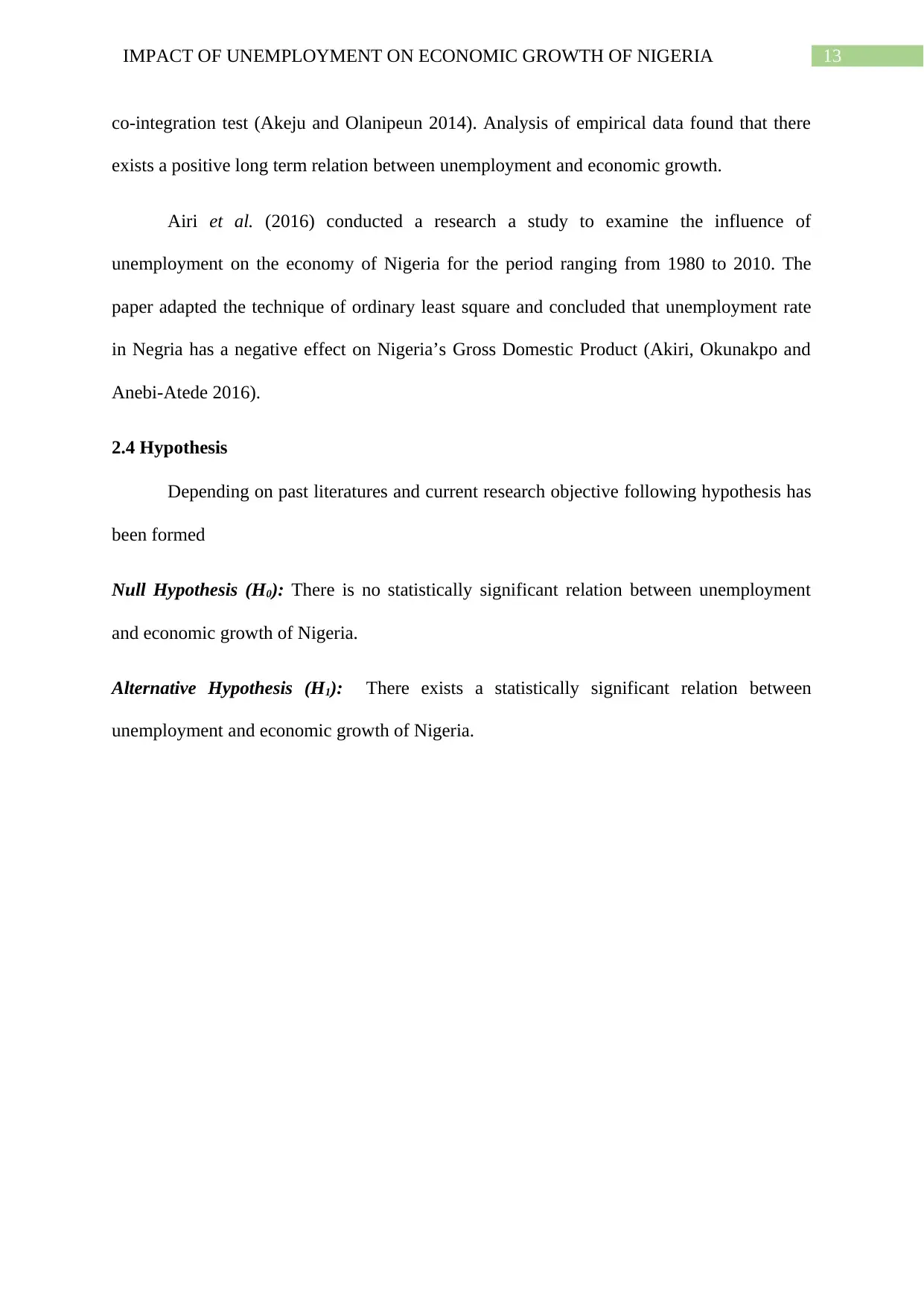
13IMPACT OF UNEMPLOYMENT ON ECONOMIC GROWTH OF NIGERIA
co-integration test (Akeju and Olanipeun 2014). Analysis of empirical data found that there
exists a positive long term relation between unemployment and economic growth.
Airi et al. (2016) conducted a research a study to examine the influence of
unemployment on the economy of Nigeria for the period ranging from 1980 to 2010. The
paper adapted the technique of ordinary least square and concluded that unemployment rate
in Negria has a negative effect on Nigeria’s Gross Domestic Product (Akiri, Okunakpo and
Anebi-Atede 2016).
2.4 Hypothesis
Depending on past literatures and current research objective following hypothesis has
been formed
Null Hypothesis (H0): There is no statistically significant relation between unemployment
and economic growth of Nigeria.
Alternative Hypothesis (H1): There exists a statistically significant relation between
unemployment and economic growth of Nigeria.
co-integration test (Akeju and Olanipeun 2014). Analysis of empirical data found that there
exists a positive long term relation between unemployment and economic growth.
Airi et al. (2016) conducted a research a study to examine the influence of
unemployment on the economy of Nigeria for the period ranging from 1980 to 2010. The
paper adapted the technique of ordinary least square and concluded that unemployment rate
in Negria has a negative effect on Nigeria’s Gross Domestic Product (Akiri, Okunakpo and
Anebi-Atede 2016).
2.4 Hypothesis
Depending on past literatures and current research objective following hypothesis has
been formed
Null Hypothesis (H0): There is no statistically significant relation between unemployment
and economic growth of Nigeria.
Alternative Hypothesis (H1): There exists a statistically significant relation between
unemployment and economic growth of Nigeria.

14IMPACT OF UNEMPLOYMENT ON ECONOMIC GROWTH OF NIGERIA
Chapter 3: Research Methodology
Selection of appropriate research methodology is an important aspect of any research
study. The research methodology consists of several sub parts such as – research philosophy,
research approach, research design, process of data collection, sampling and sample size, data
analysis method and ethical consideration.
3.1 Research Philosophy
Research philosophies are helpful in identifying essence research and suitable
research paradigm. There are four commonly known research philosophies – positivism,
interpretivism, realism and pragmatism. Particular research philosophy is chosen in consistent
with research objectives (Antwi and Hamza 2015). The present research aims to find out
impact of unemployment on unemployment on economic growth of Nigeria. The research
philosophy chosen for this purpose is positivism. The positivism philosophy seems to be
appropriate since the research has built empirical study by considering different scientific
theories and models.
3.2 Research approach
Choice of suitable research approach is one of the vital steps in conducting research
and get appropriate research outcome. The two popular research approach used in most
researches are inductive approach and deductive approach. Inductive approach indicates
establishing new models and theories after consider research outcome of the current study. In
contrast, deductive approach deals with use of past theories and models using the collected
data. Deductive approach is the most suitable for the current research (Bell, Bryman and
Harley 2018). In this research the method of quantitative data analysis has been used to arrive
at conclusion and therefore deductive approach happens to be most appropriate in this case.
Chapter 3: Research Methodology
Selection of appropriate research methodology is an important aspect of any research
study. The research methodology consists of several sub parts such as – research philosophy,
research approach, research design, process of data collection, sampling and sample size, data
analysis method and ethical consideration.
3.1 Research Philosophy
Research philosophies are helpful in identifying essence research and suitable
research paradigm. There are four commonly known research philosophies – positivism,
interpretivism, realism and pragmatism. Particular research philosophy is chosen in consistent
with research objectives (Antwi and Hamza 2015). The present research aims to find out
impact of unemployment on unemployment on economic growth of Nigeria. The research
philosophy chosen for this purpose is positivism. The positivism philosophy seems to be
appropriate since the research has built empirical study by considering different scientific
theories and models.
3.2 Research approach
Choice of suitable research approach is one of the vital steps in conducting research
and get appropriate research outcome. The two popular research approach used in most
researches are inductive approach and deductive approach. Inductive approach indicates
establishing new models and theories after consider research outcome of the current study. In
contrast, deductive approach deals with use of past theories and models using the collected
data. Deductive approach is the most suitable for the current research (Bell, Bryman and
Harley 2018). In this research the method of quantitative data analysis has been used to arrive
at conclusion and therefore deductive approach happens to be most appropriate in this case.
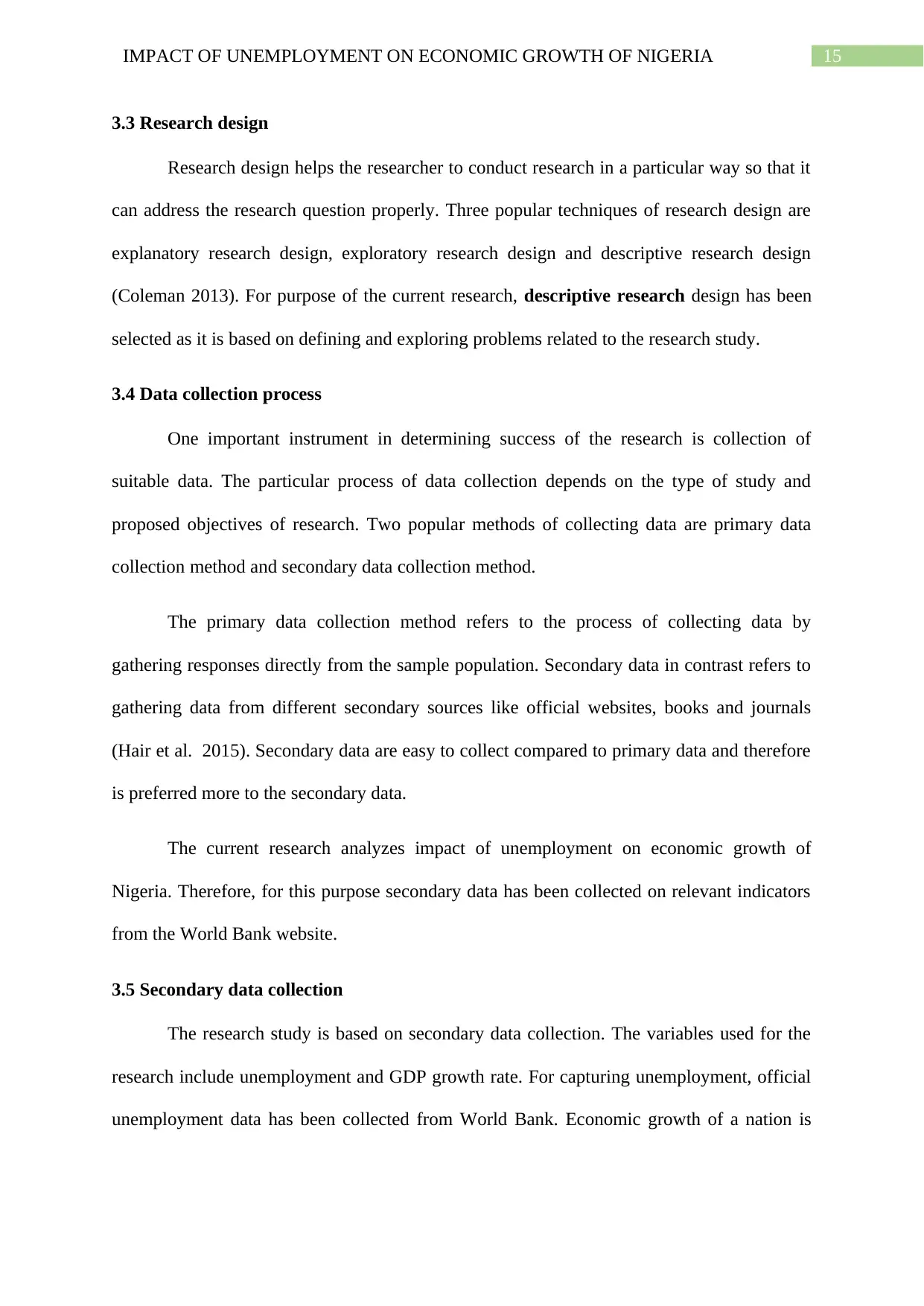
15IMPACT OF UNEMPLOYMENT ON ECONOMIC GROWTH OF NIGERIA
3.3 Research design
Research design helps the researcher to conduct research in a particular way so that it
can address the research question properly. Three popular techniques of research design are
explanatory research design, exploratory research design and descriptive research design
(Coleman 2013). For purpose of the current research, descriptive research design has been
selected as it is based on defining and exploring problems related to the research study.
3.4 Data collection process
One important instrument in determining success of the research is collection of
suitable data. The particular process of data collection depends on the type of study and
proposed objectives of research. Two popular methods of collecting data are primary data
collection method and secondary data collection method.
The primary data collection method refers to the process of collecting data by
gathering responses directly from the sample population. Secondary data in contrast refers to
gathering data from different secondary sources like official websites, books and journals
(Hair et al. 2015). Secondary data are easy to collect compared to primary data and therefore
is preferred more to the secondary data.
The current research analyzes impact of unemployment on economic growth of
Nigeria. Therefore, for this purpose secondary data has been collected on relevant indicators
from the World Bank website.
3.5 Secondary data collection
The research study is based on secondary data collection. The variables used for the
research include unemployment and GDP growth rate. For capturing unemployment, official
unemployment data has been collected from World Bank. Economic growth of a nation is
3.3 Research design
Research design helps the researcher to conduct research in a particular way so that it
can address the research question properly. Three popular techniques of research design are
explanatory research design, exploratory research design and descriptive research design
(Coleman 2013). For purpose of the current research, descriptive research design has been
selected as it is based on defining and exploring problems related to the research study.
3.4 Data collection process
One important instrument in determining success of the research is collection of
suitable data. The particular process of data collection depends on the type of study and
proposed objectives of research. Two popular methods of collecting data are primary data
collection method and secondary data collection method.
The primary data collection method refers to the process of collecting data by
gathering responses directly from the sample population. Secondary data in contrast refers to
gathering data from different secondary sources like official websites, books and journals
(Hair et al. 2015). Secondary data are easy to collect compared to primary data and therefore
is preferred more to the secondary data.
The current research analyzes impact of unemployment on economic growth of
Nigeria. Therefore, for this purpose secondary data has been collected on relevant indicators
from the World Bank website.
3.5 Secondary data collection
The research study is based on secondary data collection. The variables used for the
research include unemployment and GDP growth rate. For capturing unemployment, official
unemployment data has been collected from World Bank. Economic growth of a nation is
Secure Best Marks with AI Grader
Need help grading? Try our AI Grader for instant feedback on your assignments.
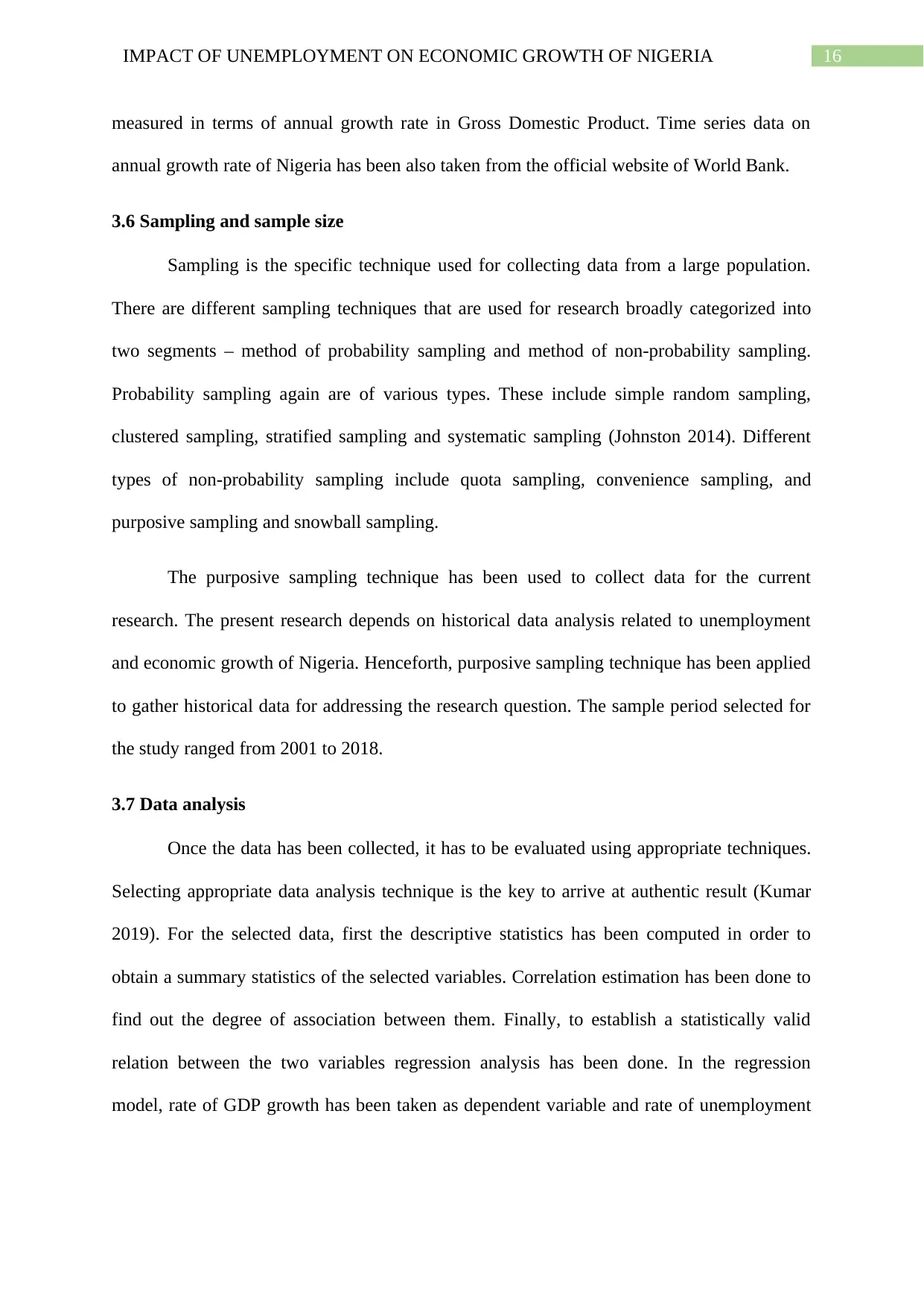
16IMPACT OF UNEMPLOYMENT ON ECONOMIC GROWTH OF NIGERIA
measured in terms of annual growth rate in Gross Domestic Product. Time series data on
annual growth rate of Nigeria has been also taken from the official website of World Bank.
3.6 Sampling and sample size
Sampling is the specific technique used for collecting data from a large population.
There are different sampling techniques that are used for research broadly categorized into
two segments – method of probability sampling and method of non-probability sampling.
Probability sampling again are of various types. These include simple random sampling,
clustered sampling, stratified sampling and systematic sampling (Johnston 2014). Different
types of non-probability sampling include quota sampling, convenience sampling, and
purposive sampling and snowball sampling.
The purposive sampling technique has been used to collect data for the current
research. The present research depends on historical data analysis related to unemployment
and economic growth of Nigeria. Henceforth, purposive sampling technique has been applied
to gather historical data for addressing the research question. The sample period selected for
the study ranged from 2001 to 2018.
3.7 Data analysis
Once the data has been collected, it has to be evaluated using appropriate techniques.
Selecting appropriate data analysis technique is the key to arrive at authentic result (Kumar
2019). For the selected data, first the descriptive statistics has been computed in order to
obtain a summary statistics of the selected variables. Correlation estimation has been done to
find out the degree of association between them. Finally, to establish a statistically valid
relation between the two variables regression analysis has been done. In the regression
model, rate of GDP growth has been taken as dependent variable and rate of unemployment
measured in terms of annual growth rate in Gross Domestic Product. Time series data on
annual growth rate of Nigeria has been also taken from the official website of World Bank.
3.6 Sampling and sample size
Sampling is the specific technique used for collecting data from a large population.
There are different sampling techniques that are used for research broadly categorized into
two segments – method of probability sampling and method of non-probability sampling.
Probability sampling again are of various types. These include simple random sampling,
clustered sampling, stratified sampling and systematic sampling (Johnston 2014). Different
types of non-probability sampling include quota sampling, convenience sampling, and
purposive sampling and snowball sampling.
The purposive sampling technique has been used to collect data for the current
research. The present research depends on historical data analysis related to unemployment
and economic growth of Nigeria. Henceforth, purposive sampling technique has been applied
to gather historical data for addressing the research question. The sample period selected for
the study ranged from 2001 to 2018.
3.7 Data analysis
Once the data has been collected, it has to be evaluated using appropriate techniques.
Selecting appropriate data analysis technique is the key to arrive at authentic result (Kumar
2019). For the selected data, first the descriptive statistics has been computed in order to
obtain a summary statistics of the selected variables. Correlation estimation has been done to
find out the degree of association between them. Finally, to establish a statistically valid
relation between the two variables regression analysis has been done. In the regression
model, rate of GDP growth has been taken as dependent variable and rate of unemployment
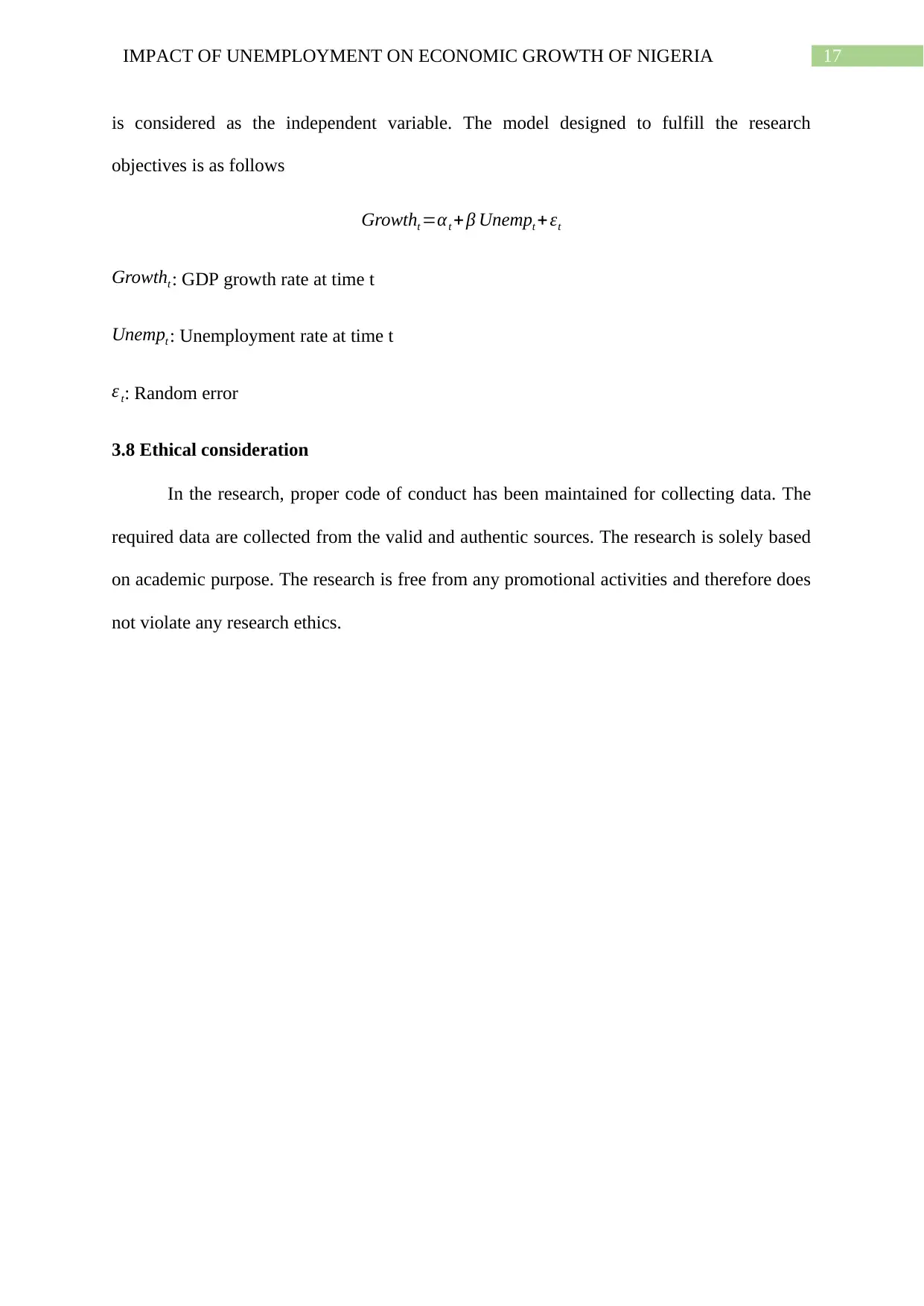
17IMPACT OF UNEMPLOYMENT ON ECONOMIC GROWTH OF NIGERIA
is considered as the independent variable. The model designed to fulfill the research
objectives is as follows
Growtht =αt +β Unempt +εt
Growtht : GDP growth rate at time t
Unempt : Unemployment rate at time t
ε t: Random error
3.8 Ethical consideration
In the research, proper code of conduct has been maintained for collecting data. The
required data are collected from the valid and authentic sources. The research is solely based
on academic purpose. The research is free from any promotional activities and therefore does
not violate any research ethics.
is considered as the independent variable. The model designed to fulfill the research
objectives is as follows
Growtht =αt +β Unempt +εt
Growtht : GDP growth rate at time t
Unempt : Unemployment rate at time t
ε t: Random error
3.8 Ethical consideration
In the research, proper code of conduct has been maintained for collecting data. The
required data are collected from the valid and authentic sources. The research is solely based
on academic purpose. The research is free from any promotional activities and therefore does
not violate any research ethics.
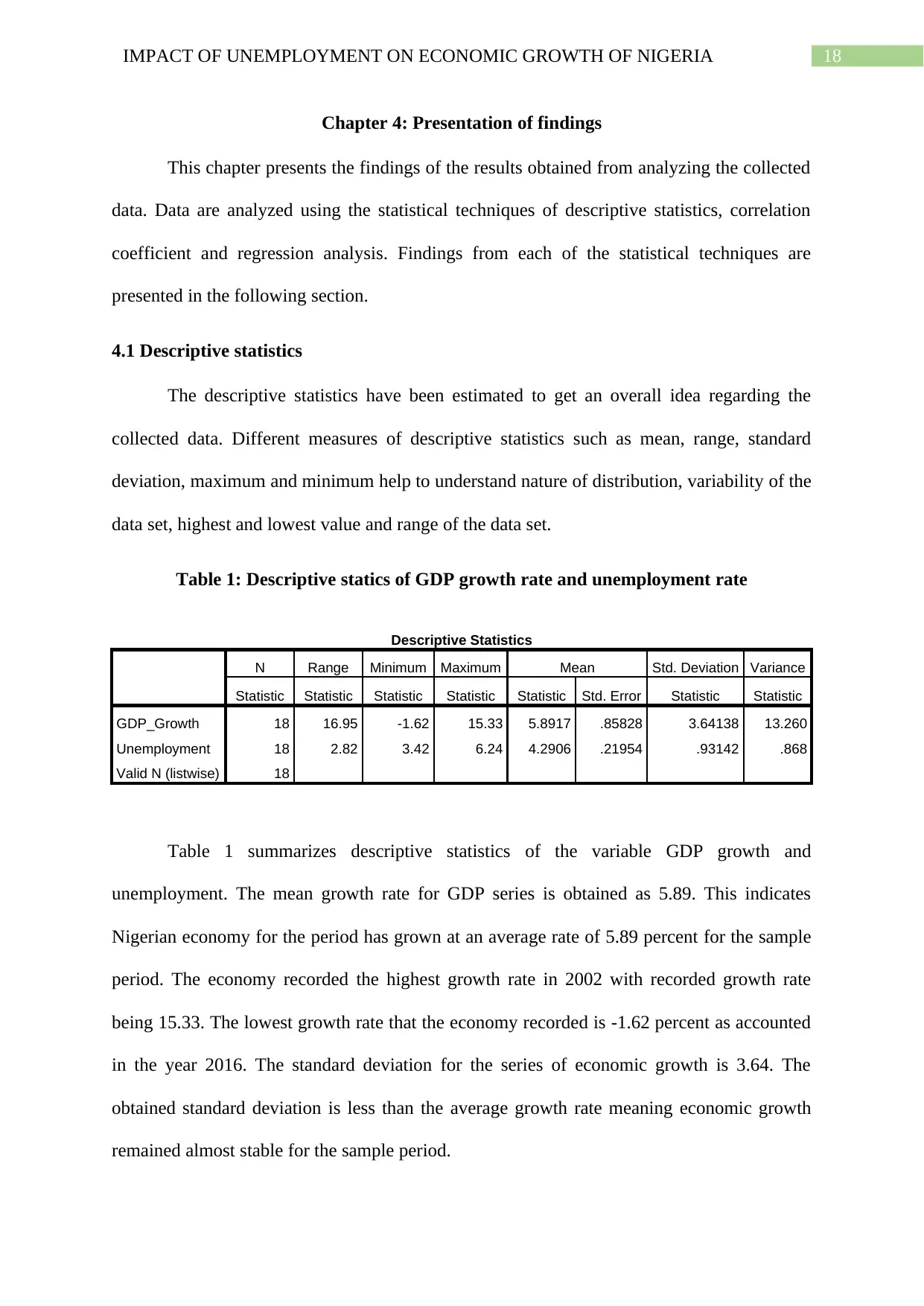
18IMPACT OF UNEMPLOYMENT ON ECONOMIC GROWTH OF NIGERIA
Chapter 4: Presentation of findings
This chapter presents the findings of the results obtained from analyzing the collected
data. Data are analyzed using the statistical techniques of descriptive statistics, correlation
coefficient and regression analysis. Findings from each of the statistical techniques are
presented in the following section.
4.1 Descriptive statistics
The descriptive statistics have been estimated to get an overall idea regarding the
collected data. Different measures of descriptive statistics such as mean, range, standard
deviation, maximum and minimum help to understand nature of distribution, variability of the
data set, highest and lowest value and range of the data set.
Table 1: Descriptive statics of GDP growth rate and unemployment rate
Descriptive Statistics
N Range Minimum Maximum Mean Std. Deviation Variance
Statistic Statistic Statistic Statistic Statistic Std. Error Statistic Statistic
GDP_Growth 18 16.95 -1.62 15.33 5.8917 .85828 3.64138 13.260
Unemployment 18 2.82 3.42 6.24 4.2906 .21954 .93142 .868
Valid N (listwise) 18
Table 1 summarizes descriptive statistics of the variable GDP growth and
unemployment. The mean growth rate for GDP series is obtained as 5.89. This indicates
Nigerian economy for the period has grown at an average rate of 5.89 percent for the sample
period. The economy recorded the highest growth rate in 2002 with recorded growth rate
being 15.33. The lowest growth rate that the economy recorded is -1.62 percent as accounted
in the year 2016. The standard deviation for the series of economic growth is 3.64. The
obtained standard deviation is less than the average growth rate meaning economic growth
remained almost stable for the sample period.
Chapter 4: Presentation of findings
This chapter presents the findings of the results obtained from analyzing the collected
data. Data are analyzed using the statistical techniques of descriptive statistics, correlation
coefficient and regression analysis. Findings from each of the statistical techniques are
presented in the following section.
4.1 Descriptive statistics
The descriptive statistics have been estimated to get an overall idea regarding the
collected data. Different measures of descriptive statistics such as mean, range, standard
deviation, maximum and minimum help to understand nature of distribution, variability of the
data set, highest and lowest value and range of the data set.
Table 1: Descriptive statics of GDP growth rate and unemployment rate
Descriptive Statistics
N Range Minimum Maximum Mean Std. Deviation Variance
Statistic Statistic Statistic Statistic Statistic Std. Error Statistic Statistic
GDP_Growth 18 16.95 -1.62 15.33 5.8917 .85828 3.64138 13.260
Unemployment 18 2.82 3.42 6.24 4.2906 .21954 .93142 .868
Valid N (listwise) 18
Table 1 summarizes descriptive statistics of the variable GDP growth and
unemployment. The mean growth rate for GDP series is obtained as 5.89. This indicates
Nigerian economy for the period has grown at an average rate of 5.89 percent for the sample
period. The economy recorded the highest growth rate in 2002 with recorded growth rate
being 15.33. The lowest growth rate that the economy recorded is -1.62 percent as accounted
in the year 2016. The standard deviation for the series of economic growth is 3.64. The
obtained standard deviation is less than the average growth rate meaning economic growth
remained almost stable for the sample period.
Paraphrase This Document
Need a fresh take? Get an instant paraphrase of this document with our AI Paraphraser
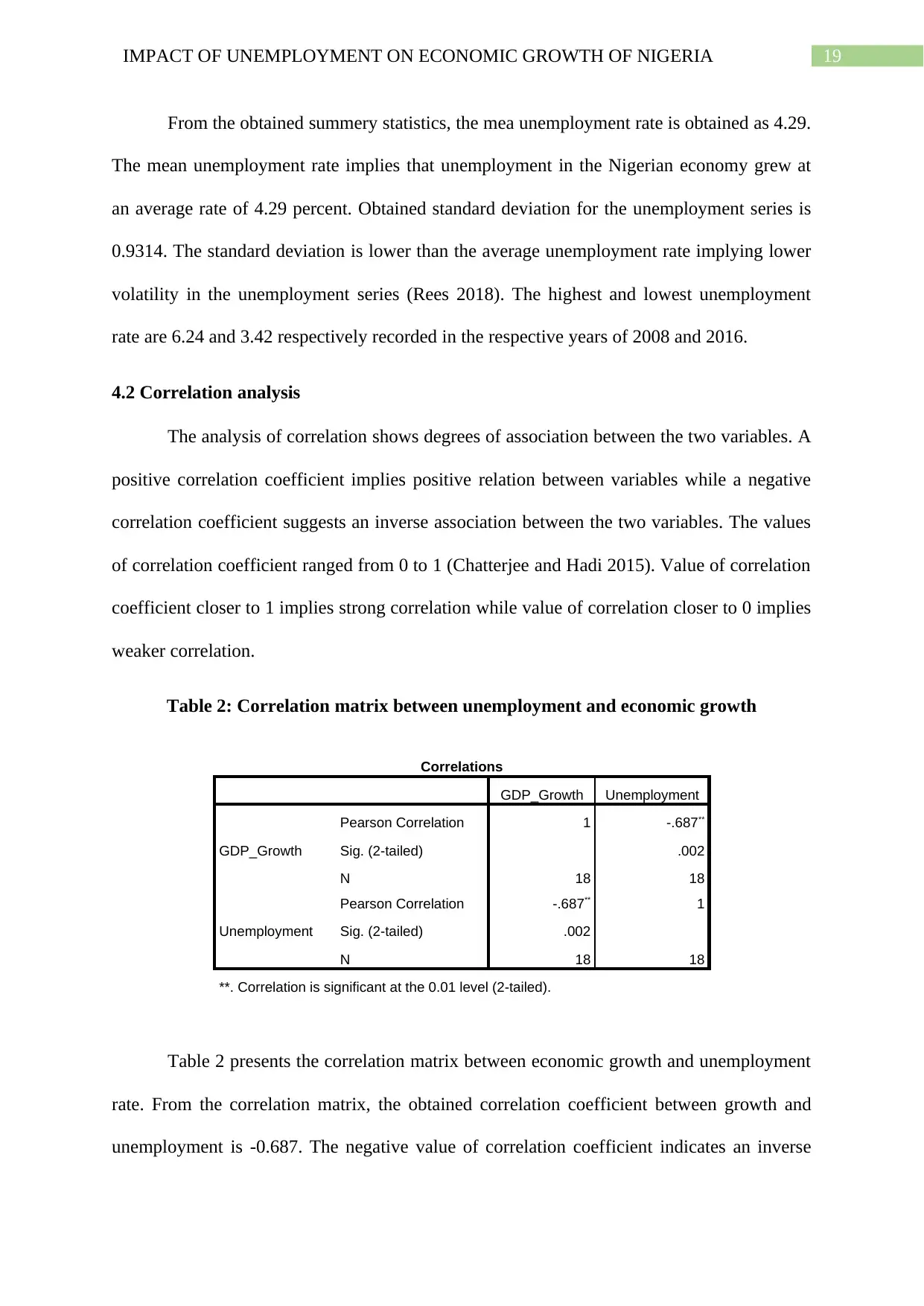
19IMPACT OF UNEMPLOYMENT ON ECONOMIC GROWTH OF NIGERIA
From the obtained summery statistics, the mea unemployment rate is obtained as 4.29.
The mean unemployment rate implies that unemployment in the Nigerian economy grew at
an average rate of 4.29 percent. Obtained standard deviation for the unemployment series is
0.9314. The standard deviation is lower than the average unemployment rate implying lower
volatility in the unemployment series (Rees 2018). The highest and lowest unemployment
rate are 6.24 and 3.42 respectively recorded in the respective years of 2008 and 2016.
4.2 Correlation analysis
The analysis of correlation shows degrees of association between the two variables. A
positive correlation coefficient implies positive relation between variables while a negative
correlation coefficient suggests an inverse association between the two variables. The values
of correlation coefficient ranged from 0 to 1 (Chatterjee and Hadi 2015). Value of correlation
coefficient closer to 1 implies strong correlation while value of correlation closer to 0 implies
weaker correlation.
Table 2: Correlation matrix between unemployment and economic growth
Correlations
GDP_Growth Unemployment
GDP_Growth
Pearson Correlation 1 -.687**
Sig. (2-tailed) .002
N 18 18
Unemployment
Pearson Correlation -.687** 1
Sig. (2-tailed) .002
N 18 18
**. Correlation is significant at the 0.01 level (2-tailed).
Table 2 presents the correlation matrix between economic growth and unemployment
rate. From the correlation matrix, the obtained correlation coefficient between growth and
unemployment is -0.687. The negative value of correlation coefficient indicates an inverse
From the obtained summery statistics, the mea unemployment rate is obtained as 4.29.
The mean unemployment rate implies that unemployment in the Nigerian economy grew at
an average rate of 4.29 percent. Obtained standard deviation for the unemployment series is
0.9314. The standard deviation is lower than the average unemployment rate implying lower
volatility in the unemployment series (Rees 2018). The highest and lowest unemployment
rate are 6.24 and 3.42 respectively recorded in the respective years of 2008 and 2016.
4.2 Correlation analysis
The analysis of correlation shows degrees of association between the two variables. A
positive correlation coefficient implies positive relation between variables while a negative
correlation coefficient suggests an inverse association between the two variables. The values
of correlation coefficient ranged from 0 to 1 (Chatterjee and Hadi 2015). Value of correlation
coefficient closer to 1 implies strong correlation while value of correlation closer to 0 implies
weaker correlation.
Table 2: Correlation matrix between unemployment and economic growth
Correlations
GDP_Growth Unemployment
GDP_Growth
Pearson Correlation 1 -.687**
Sig. (2-tailed) .002
N 18 18
Unemployment
Pearson Correlation -.687** 1
Sig. (2-tailed) .002
N 18 18
**. Correlation is significant at the 0.01 level (2-tailed).
Table 2 presents the correlation matrix between economic growth and unemployment
rate. From the correlation matrix, the obtained correlation coefficient between growth and
unemployment is -0.687. The negative value of correlation coefficient indicates an inverse
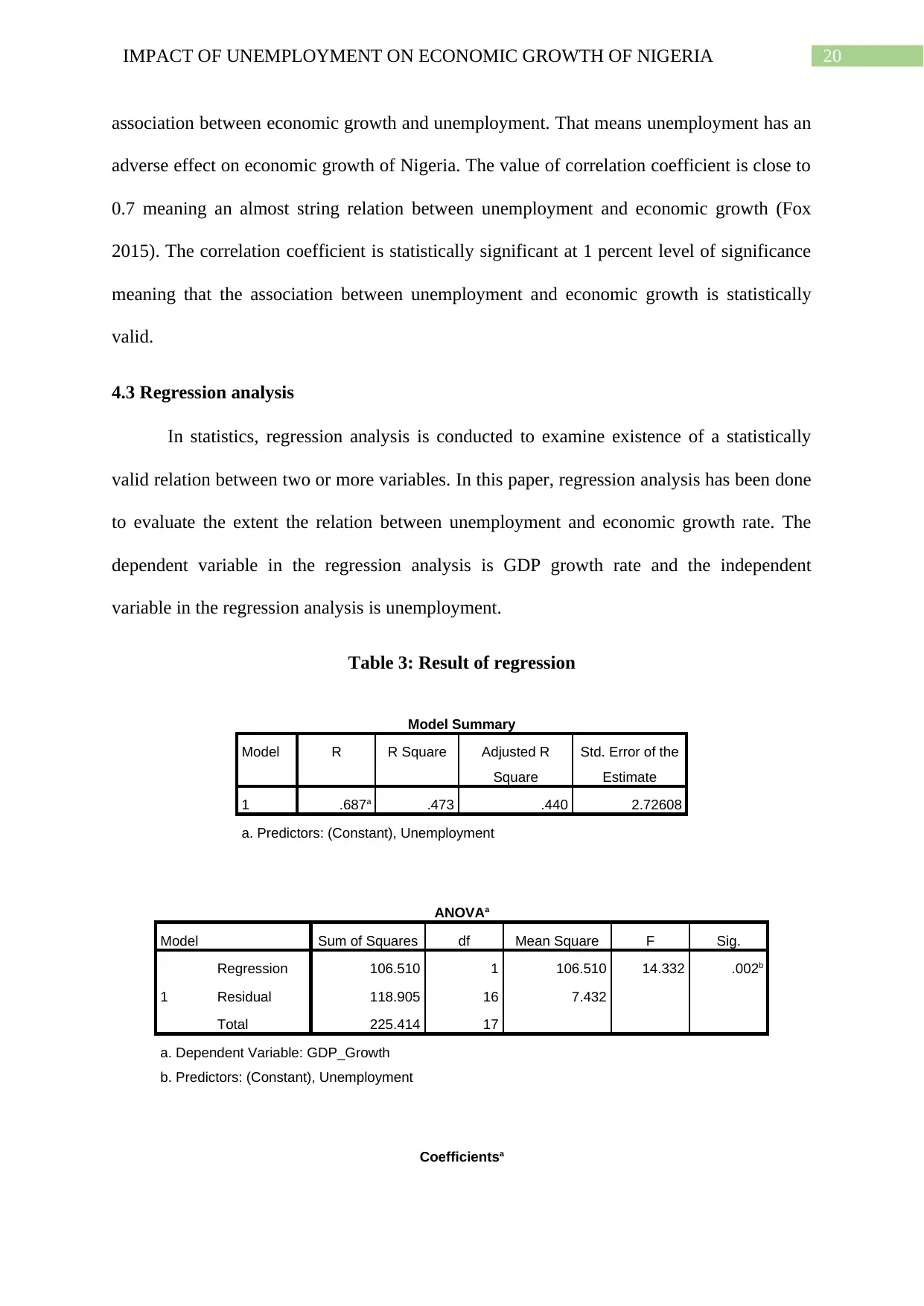
20IMPACT OF UNEMPLOYMENT ON ECONOMIC GROWTH OF NIGERIA
association between economic growth and unemployment. That means unemployment has an
adverse effect on economic growth of Nigeria. The value of correlation coefficient is close to
0.7 meaning an almost string relation between unemployment and economic growth (Fox
2015). The correlation coefficient is statistically significant at 1 percent level of significance
meaning that the association between unemployment and economic growth is statistically
valid.
4.3 Regression analysis
In statistics, regression analysis is conducted to examine existence of a statistically
valid relation between two or more variables. In this paper, regression analysis has been done
to evaluate the extent the relation between unemployment and economic growth rate. The
dependent variable in the regression analysis is GDP growth rate and the independent
variable in the regression analysis is unemployment.
Table 3: Result of regression
Model Summary
Model R R Square Adjusted R
Square
Std. Error of the
Estimate
1 .687a .473 .440 2.72608
a. Predictors: (Constant), Unemployment
ANOVAa
Model Sum of Squares df Mean Square F Sig.
1
Regression 106.510 1 106.510 14.332 .002b
Residual 118.905 16 7.432
Total 225.414 17
a. Dependent Variable: GDP_Growth
b. Predictors: (Constant), Unemployment
Coefficientsa
association between economic growth and unemployment. That means unemployment has an
adverse effect on economic growth of Nigeria. The value of correlation coefficient is close to
0.7 meaning an almost string relation between unemployment and economic growth (Fox
2015). The correlation coefficient is statistically significant at 1 percent level of significance
meaning that the association between unemployment and economic growth is statistically
valid.
4.3 Regression analysis
In statistics, regression analysis is conducted to examine existence of a statistically
valid relation between two or more variables. In this paper, regression analysis has been done
to evaluate the extent the relation between unemployment and economic growth rate. The
dependent variable in the regression analysis is GDP growth rate and the independent
variable in the regression analysis is unemployment.
Table 3: Result of regression
Model Summary
Model R R Square Adjusted R
Square
Std. Error of the
Estimate
1 .687a .473 .440 2.72608
a. Predictors: (Constant), Unemployment
ANOVAa
Model Sum of Squares df Mean Square F Sig.
1
Regression 106.510 1 106.510 14.332 .002b
Residual 118.905 16 7.432
Total 225.414 17
a. Dependent Variable: GDP_Growth
b. Predictors: (Constant), Unemployment
Coefficientsa
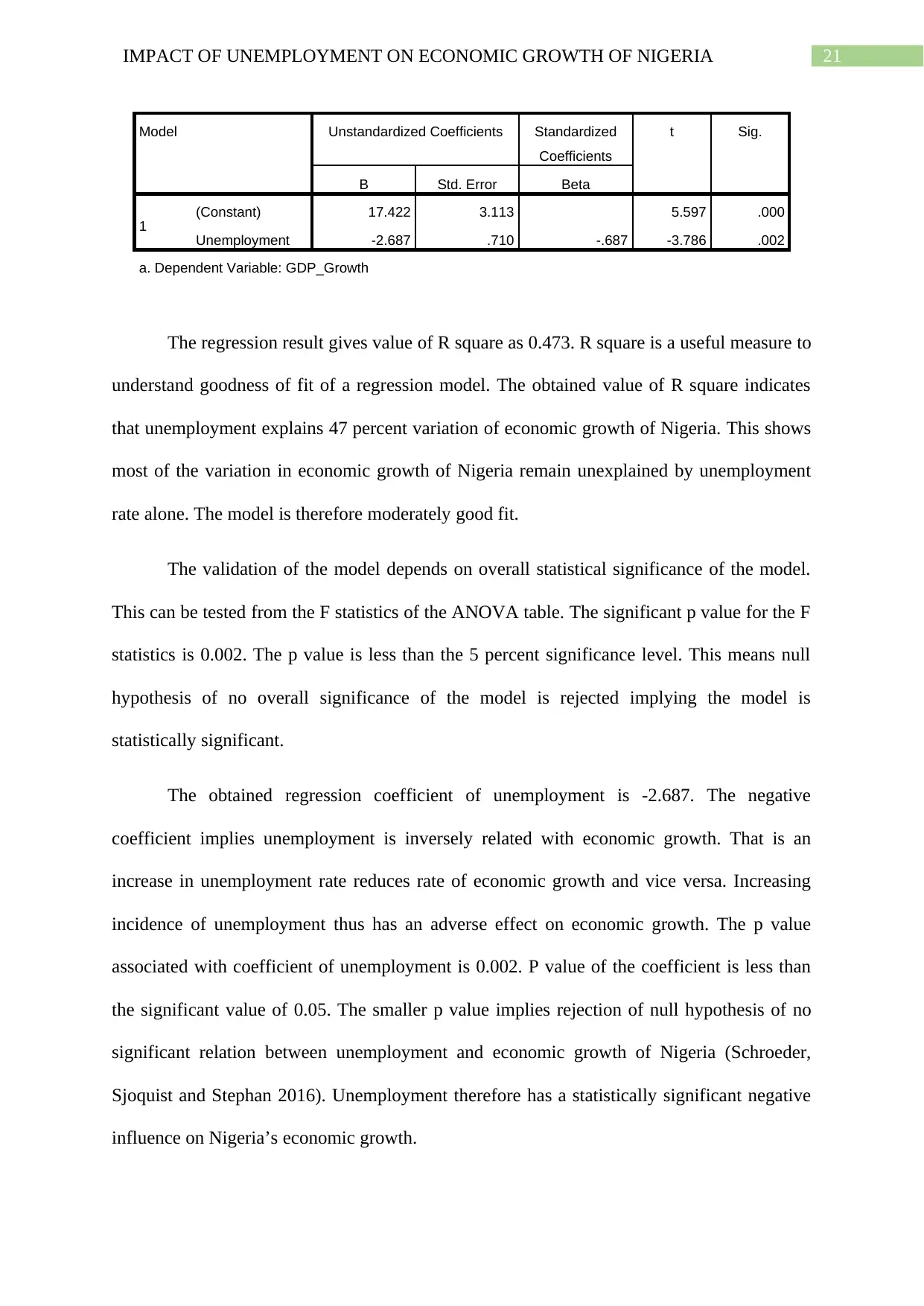
21IMPACT OF UNEMPLOYMENT ON ECONOMIC GROWTH OF NIGERIA
Model Unstandardized Coefficients Standardized
Coefficients
t Sig.
B Std. Error Beta
1 (Constant) 17.422 3.113 5.597 .000
Unemployment -2.687 .710 -.687 -3.786 .002
a. Dependent Variable: GDP_Growth
The regression result gives value of R square as 0.473. R square is a useful measure to
understand goodness of fit of a regression model. The obtained value of R square indicates
that unemployment explains 47 percent variation of economic growth of Nigeria. This shows
most of the variation in economic growth of Nigeria remain unexplained by unemployment
rate alone. The model is therefore moderately good fit.
The validation of the model depends on overall statistical significance of the model.
This can be tested from the F statistics of the ANOVA table. The significant p value for the F
statistics is 0.002. The p value is less than the 5 percent significance level. This means null
hypothesis of no overall significance of the model is rejected implying the model is
statistically significant.
The obtained regression coefficient of unemployment is -2.687. The negative
coefficient implies unemployment is inversely related with economic growth. That is an
increase in unemployment rate reduces rate of economic growth and vice versa. Increasing
incidence of unemployment thus has an adverse effect on economic growth. The p value
associated with coefficient of unemployment is 0.002. P value of the coefficient is less than
the significant value of 0.05. The smaller p value implies rejection of null hypothesis of no
significant relation between unemployment and economic growth of Nigeria (Schroeder,
Sjoquist and Stephan 2016). Unemployment therefore has a statistically significant negative
influence on Nigeria’s economic growth.
Model Unstandardized Coefficients Standardized
Coefficients
t Sig.
B Std. Error Beta
1 (Constant) 17.422 3.113 5.597 .000
Unemployment -2.687 .710 -.687 -3.786 .002
a. Dependent Variable: GDP_Growth
The regression result gives value of R square as 0.473. R square is a useful measure to
understand goodness of fit of a regression model. The obtained value of R square indicates
that unemployment explains 47 percent variation of economic growth of Nigeria. This shows
most of the variation in economic growth of Nigeria remain unexplained by unemployment
rate alone. The model is therefore moderately good fit.
The validation of the model depends on overall statistical significance of the model.
This can be tested from the F statistics of the ANOVA table. The significant p value for the F
statistics is 0.002. The p value is less than the 5 percent significance level. This means null
hypothesis of no overall significance of the model is rejected implying the model is
statistically significant.
The obtained regression coefficient of unemployment is -2.687. The negative
coefficient implies unemployment is inversely related with economic growth. That is an
increase in unemployment rate reduces rate of economic growth and vice versa. Increasing
incidence of unemployment thus has an adverse effect on economic growth. The p value
associated with coefficient of unemployment is 0.002. P value of the coefficient is less than
the significant value of 0.05. The smaller p value implies rejection of null hypothesis of no
significant relation between unemployment and economic growth of Nigeria (Schroeder,
Sjoquist and Stephan 2016). Unemployment therefore has a statistically significant negative
influence on Nigeria’s economic growth.
Secure Best Marks with AI Grader
Need help grading? Try our AI Grader for instant feedback on your assignments.

22IMPACT OF UNEMPLOYMENT ON ECONOMIC GROWTH OF NIGERIA
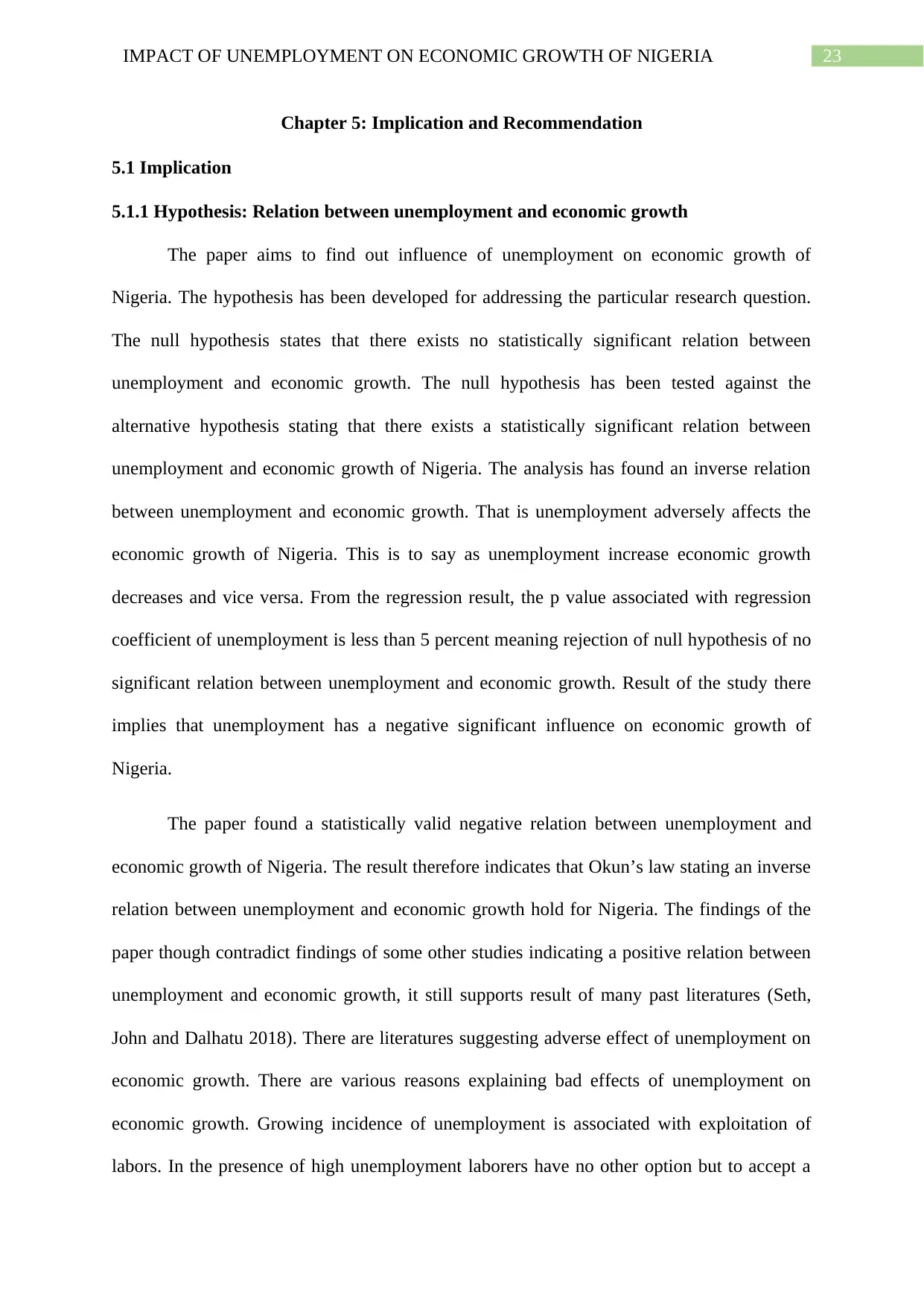
23IMPACT OF UNEMPLOYMENT ON ECONOMIC GROWTH OF NIGERIA
Chapter 5: Implication and Recommendation
5.1 Implication
5.1.1 Hypothesis: Relation between unemployment and economic growth
The paper aims to find out influence of unemployment on economic growth of
Nigeria. The hypothesis has been developed for addressing the particular research question.
The null hypothesis states that there exists no statistically significant relation between
unemployment and economic growth. The null hypothesis has been tested against the
alternative hypothesis stating that there exists a statistically significant relation between
unemployment and economic growth of Nigeria. The analysis has found an inverse relation
between unemployment and economic growth. That is unemployment adversely affects the
economic growth of Nigeria. This is to say as unemployment increase economic growth
decreases and vice versa. From the regression result, the p value associated with regression
coefficient of unemployment is less than 5 percent meaning rejection of null hypothesis of no
significant relation between unemployment and economic growth. Result of the study there
implies that unemployment has a negative significant influence on economic growth of
Nigeria.
The paper found a statistically valid negative relation between unemployment and
economic growth of Nigeria. The result therefore indicates that Okun’s law stating an inverse
relation between unemployment and economic growth hold for Nigeria. The findings of the
paper though contradict findings of some other studies indicating a positive relation between
unemployment and economic growth, it still supports result of many past literatures (Seth,
John and Dalhatu 2018). There are literatures suggesting adverse effect of unemployment on
economic growth. There are various reasons explaining bad effects of unemployment on
economic growth. Growing incidence of unemployment is associated with exploitation of
labors. In the presence of high unemployment laborers have no other option but to accept a
Chapter 5: Implication and Recommendation
5.1 Implication
5.1.1 Hypothesis: Relation between unemployment and economic growth
The paper aims to find out influence of unemployment on economic growth of
Nigeria. The hypothesis has been developed for addressing the particular research question.
The null hypothesis states that there exists no statistically significant relation between
unemployment and economic growth. The null hypothesis has been tested against the
alternative hypothesis stating that there exists a statistically significant relation between
unemployment and economic growth of Nigeria. The analysis has found an inverse relation
between unemployment and economic growth. That is unemployment adversely affects the
economic growth of Nigeria. This is to say as unemployment increase economic growth
decreases and vice versa. From the regression result, the p value associated with regression
coefficient of unemployment is less than 5 percent meaning rejection of null hypothesis of no
significant relation between unemployment and economic growth. Result of the study there
implies that unemployment has a negative significant influence on economic growth of
Nigeria.
The paper found a statistically valid negative relation between unemployment and
economic growth of Nigeria. The result therefore indicates that Okun’s law stating an inverse
relation between unemployment and economic growth hold for Nigeria. The findings of the
paper though contradict findings of some other studies indicating a positive relation between
unemployment and economic growth, it still supports result of many past literatures (Seth,
John and Dalhatu 2018). There are literatures suggesting adverse effect of unemployment on
economic growth. There are various reasons explaining bad effects of unemployment on
economic growth. Growing incidence of unemployment is associated with exploitation of
labors. In the presence of high unemployment laborers have no other option but to accept a
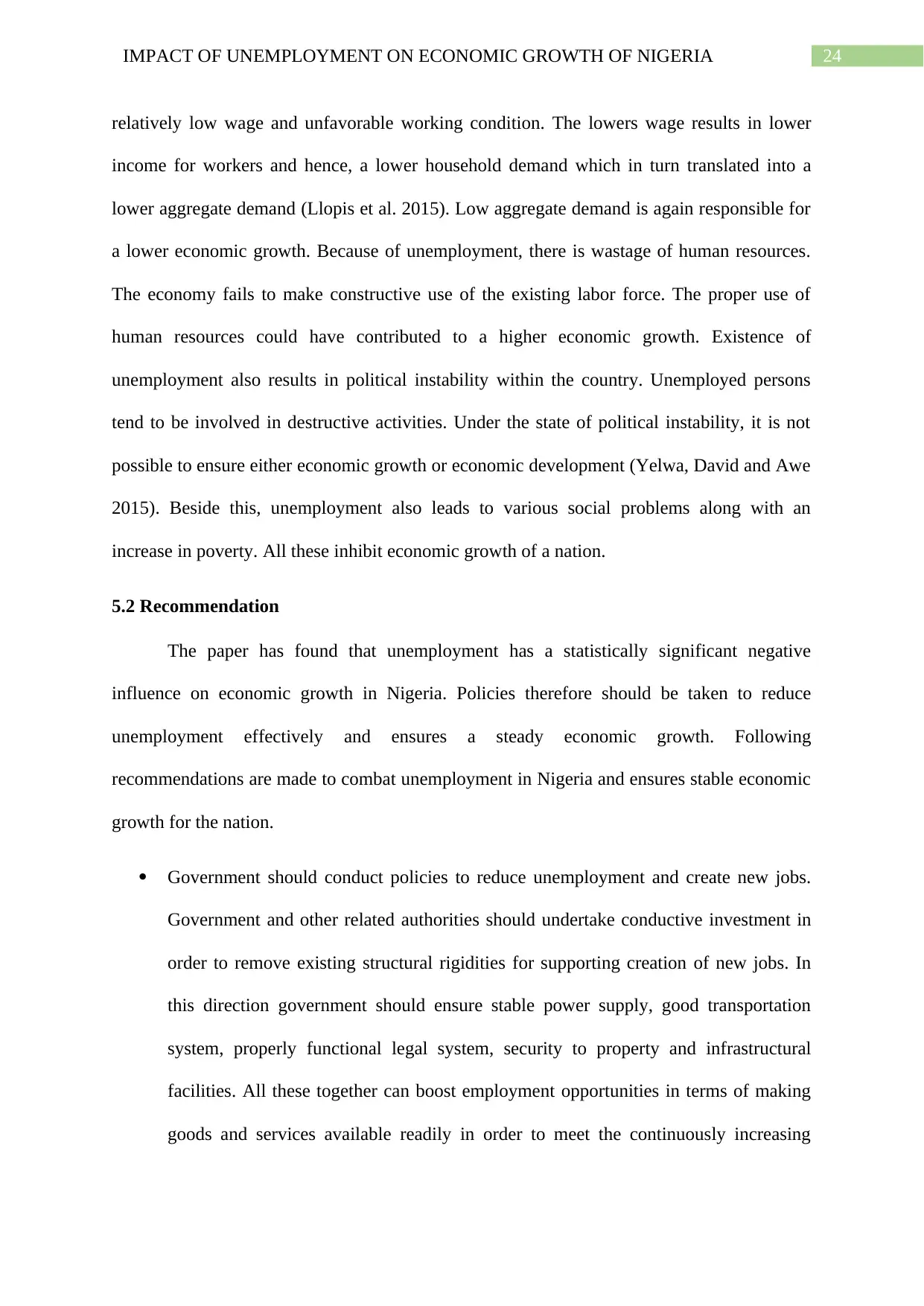
24IMPACT OF UNEMPLOYMENT ON ECONOMIC GROWTH OF NIGERIA
relatively low wage and unfavorable working condition. The lowers wage results in lower
income for workers and hence, a lower household demand which in turn translated into a
lower aggregate demand (Llopis et al. 2015). Low aggregate demand is again responsible for
a lower economic growth. Because of unemployment, there is wastage of human resources.
The economy fails to make constructive use of the existing labor force. The proper use of
human resources could have contributed to a higher economic growth. Existence of
unemployment also results in political instability within the country. Unemployed persons
tend to be involved in destructive activities. Under the state of political instability, it is not
possible to ensure either economic growth or economic development (Yelwa, David and Awe
2015). Beside this, unemployment also leads to various social problems along with an
increase in poverty. All these inhibit economic growth of a nation.
5.2 Recommendation
The paper has found that unemployment has a statistically significant negative
influence on economic growth in Nigeria. Policies therefore should be taken to reduce
unemployment effectively and ensures a steady economic growth. Following
recommendations are made to combat unemployment in Nigeria and ensures stable economic
growth for the nation.
Government should conduct policies to reduce unemployment and create new jobs.
Government and other related authorities should undertake conductive investment in
order to remove existing structural rigidities for supporting creation of new jobs. In
this direction government should ensure stable power supply, good transportation
system, properly functional legal system, security to property and infrastructural
facilities. All these together can boost employment opportunities in terms of making
goods and services available readily in order to meet the continuously increasing
relatively low wage and unfavorable working condition. The lowers wage results in lower
income for workers and hence, a lower household demand which in turn translated into a
lower aggregate demand (Llopis et al. 2015). Low aggregate demand is again responsible for
a lower economic growth. Because of unemployment, there is wastage of human resources.
The economy fails to make constructive use of the existing labor force. The proper use of
human resources could have contributed to a higher economic growth. Existence of
unemployment also results in political instability within the country. Unemployed persons
tend to be involved in destructive activities. Under the state of political instability, it is not
possible to ensure either economic growth or economic development (Yelwa, David and Awe
2015). Beside this, unemployment also leads to various social problems along with an
increase in poverty. All these inhibit economic growth of a nation.
5.2 Recommendation
The paper has found that unemployment has a statistically significant negative
influence on economic growth in Nigeria. Policies therefore should be taken to reduce
unemployment effectively and ensures a steady economic growth. Following
recommendations are made to combat unemployment in Nigeria and ensures stable economic
growth for the nation.
Government should conduct policies to reduce unemployment and create new jobs.
Government and other related authorities should undertake conductive investment in
order to remove existing structural rigidities for supporting creation of new jobs. In
this direction government should ensure stable power supply, good transportation
system, properly functional legal system, security to property and infrastructural
facilities. All these together can boost employment opportunities in terms of making
goods and services available readily in order to meet the continuously increasing
Paraphrase This Document
Need a fresh take? Get an instant paraphrase of this document with our AI Paraphraser
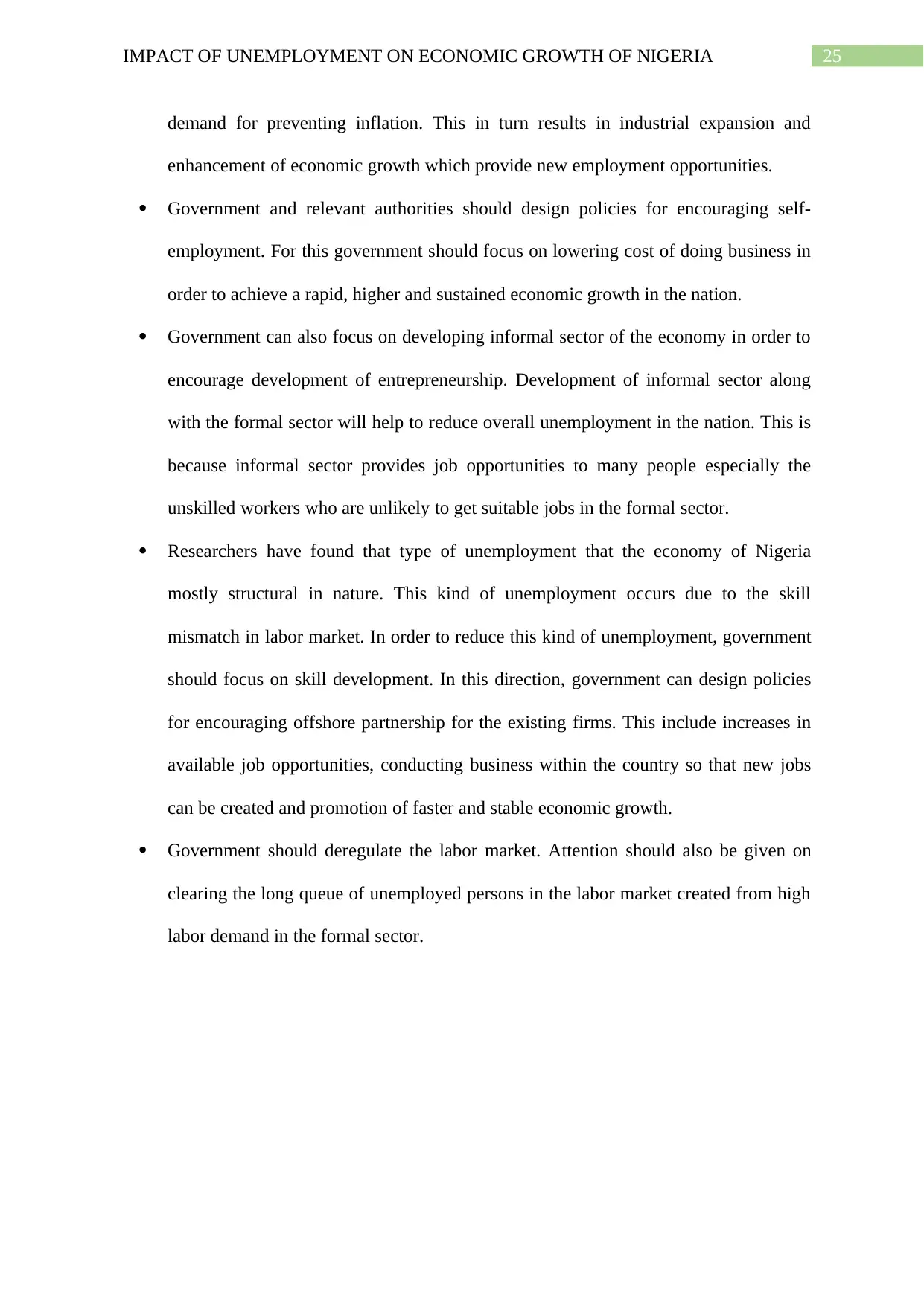
25IMPACT OF UNEMPLOYMENT ON ECONOMIC GROWTH OF NIGERIA
demand for preventing inflation. This in turn results in industrial expansion and
enhancement of economic growth which provide new employment opportunities.
Government and relevant authorities should design policies for encouraging self-
employment. For this government should focus on lowering cost of doing business in
order to achieve a rapid, higher and sustained economic growth in the nation.
Government can also focus on developing informal sector of the economy in order to
encourage development of entrepreneurship. Development of informal sector along
with the formal sector will help to reduce overall unemployment in the nation. This is
because informal sector provides job opportunities to many people especially the
unskilled workers who are unlikely to get suitable jobs in the formal sector.
Researchers have found that type of unemployment that the economy of Nigeria
mostly structural in nature. This kind of unemployment occurs due to the skill
mismatch in labor market. In order to reduce this kind of unemployment, government
should focus on skill development. In this direction, government can design policies
for encouraging offshore partnership for the existing firms. This include increases in
available job opportunities, conducting business within the country so that new jobs
can be created and promotion of faster and stable economic growth.
Government should deregulate the labor market. Attention should also be given on
clearing the long queue of unemployed persons in the labor market created from high
labor demand in the formal sector.
demand for preventing inflation. This in turn results in industrial expansion and
enhancement of economic growth which provide new employment opportunities.
Government and relevant authorities should design policies for encouraging self-
employment. For this government should focus on lowering cost of doing business in
order to achieve a rapid, higher and sustained economic growth in the nation.
Government can also focus on developing informal sector of the economy in order to
encourage development of entrepreneurship. Development of informal sector along
with the formal sector will help to reduce overall unemployment in the nation. This is
because informal sector provides job opportunities to many people especially the
unskilled workers who are unlikely to get suitable jobs in the formal sector.
Researchers have found that type of unemployment that the economy of Nigeria
mostly structural in nature. This kind of unemployment occurs due to the skill
mismatch in labor market. In order to reduce this kind of unemployment, government
should focus on skill development. In this direction, government can design policies
for encouraging offshore partnership for the existing firms. This include increases in
available job opportunities, conducting business within the country so that new jobs
can be created and promotion of faster and stable economic growth.
Government should deregulate the labor market. Attention should also be given on
clearing the long queue of unemployed persons in the labor market created from high
labor demand in the formal sector.

26IMPACT OF UNEMPLOYMENT ON ECONOMIC GROWTH OF NIGERIA
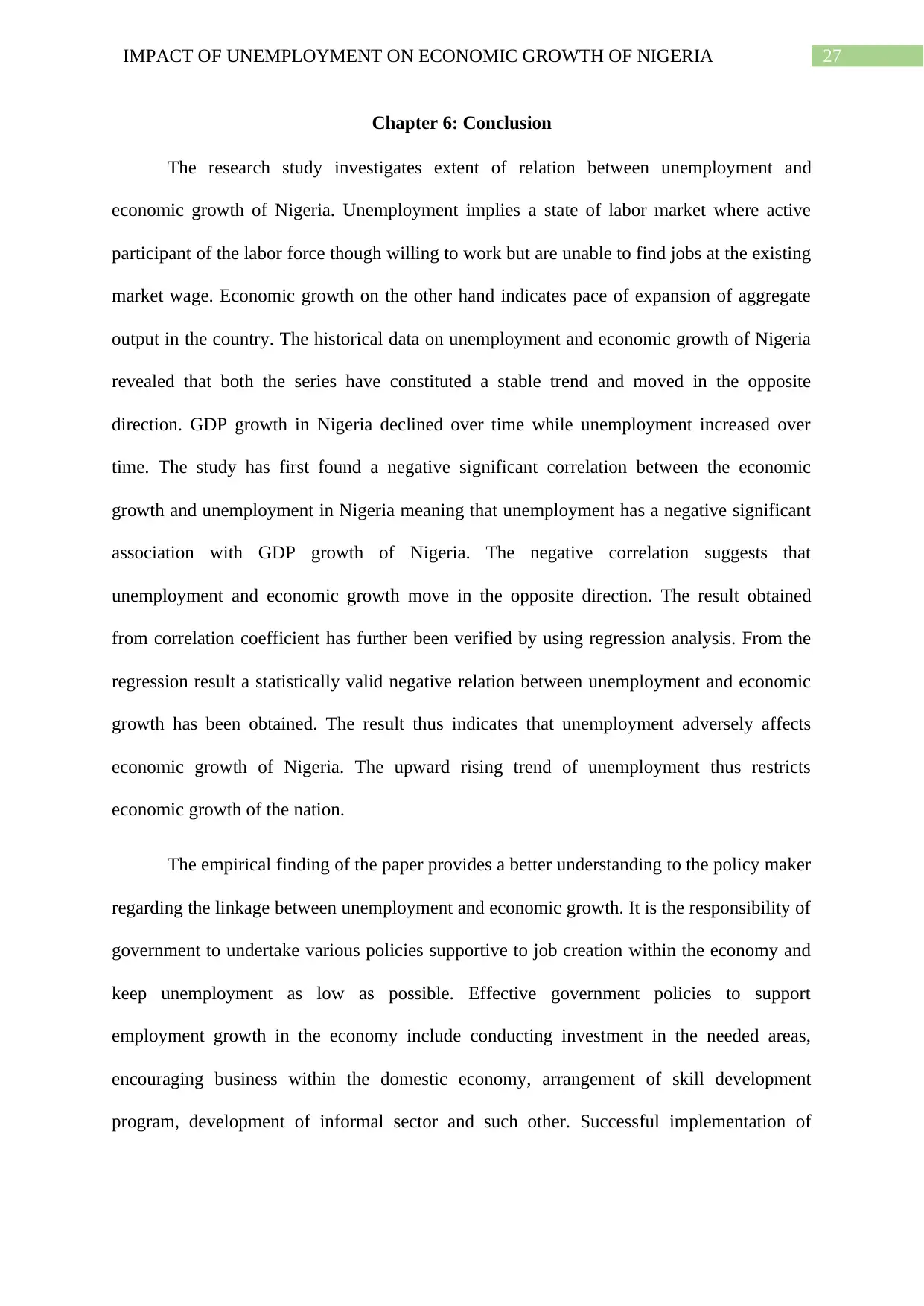
27IMPACT OF UNEMPLOYMENT ON ECONOMIC GROWTH OF NIGERIA
Chapter 6: Conclusion
The research study investigates extent of relation between unemployment and
economic growth of Nigeria. Unemployment implies a state of labor market where active
participant of the labor force though willing to work but are unable to find jobs at the existing
market wage. Economic growth on the other hand indicates pace of expansion of aggregate
output in the country. The historical data on unemployment and economic growth of Nigeria
revealed that both the series have constituted a stable trend and moved in the opposite
direction. GDP growth in Nigeria declined over time while unemployment increased over
time. The study has first found a negative significant correlation between the economic
growth and unemployment in Nigeria meaning that unemployment has a negative significant
association with GDP growth of Nigeria. The negative correlation suggests that
unemployment and economic growth move in the opposite direction. The result obtained
from correlation coefficient has further been verified by using regression analysis. From the
regression result a statistically valid negative relation between unemployment and economic
growth has been obtained. The result thus indicates that unemployment adversely affects
economic growth of Nigeria. The upward rising trend of unemployment thus restricts
economic growth of the nation.
The empirical finding of the paper provides a better understanding to the policy maker
regarding the linkage between unemployment and economic growth. It is the responsibility of
government to undertake various policies supportive to job creation within the economy and
keep unemployment as low as possible. Effective government policies to support
employment growth in the economy include conducting investment in the needed areas,
encouraging business within the domestic economy, arrangement of skill development
program, development of informal sector and such other. Successful implementation of
Chapter 6: Conclusion
The research study investigates extent of relation between unemployment and
economic growth of Nigeria. Unemployment implies a state of labor market where active
participant of the labor force though willing to work but are unable to find jobs at the existing
market wage. Economic growth on the other hand indicates pace of expansion of aggregate
output in the country. The historical data on unemployment and economic growth of Nigeria
revealed that both the series have constituted a stable trend and moved in the opposite
direction. GDP growth in Nigeria declined over time while unemployment increased over
time. The study has first found a negative significant correlation between the economic
growth and unemployment in Nigeria meaning that unemployment has a negative significant
association with GDP growth of Nigeria. The negative correlation suggests that
unemployment and economic growth move in the opposite direction. The result obtained
from correlation coefficient has further been verified by using regression analysis. From the
regression result a statistically valid negative relation between unemployment and economic
growth has been obtained. The result thus indicates that unemployment adversely affects
economic growth of Nigeria. The upward rising trend of unemployment thus restricts
economic growth of the nation.
The empirical finding of the paper provides a better understanding to the policy maker
regarding the linkage between unemployment and economic growth. It is the responsibility of
government to undertake various policies supportive to job creation within the economy and
keep unemployment as low as possible. Effective government policies to support
employment growth in the economy include conducting investment in the needed areas,
encouraging business within the domestic economy, arrangement of skill development
program, development of informal sector and such other. Successful implementation of
Secure Best Marks with AI Grader
Need help grading? Try our AI Grader for instant feedback on your assignments.
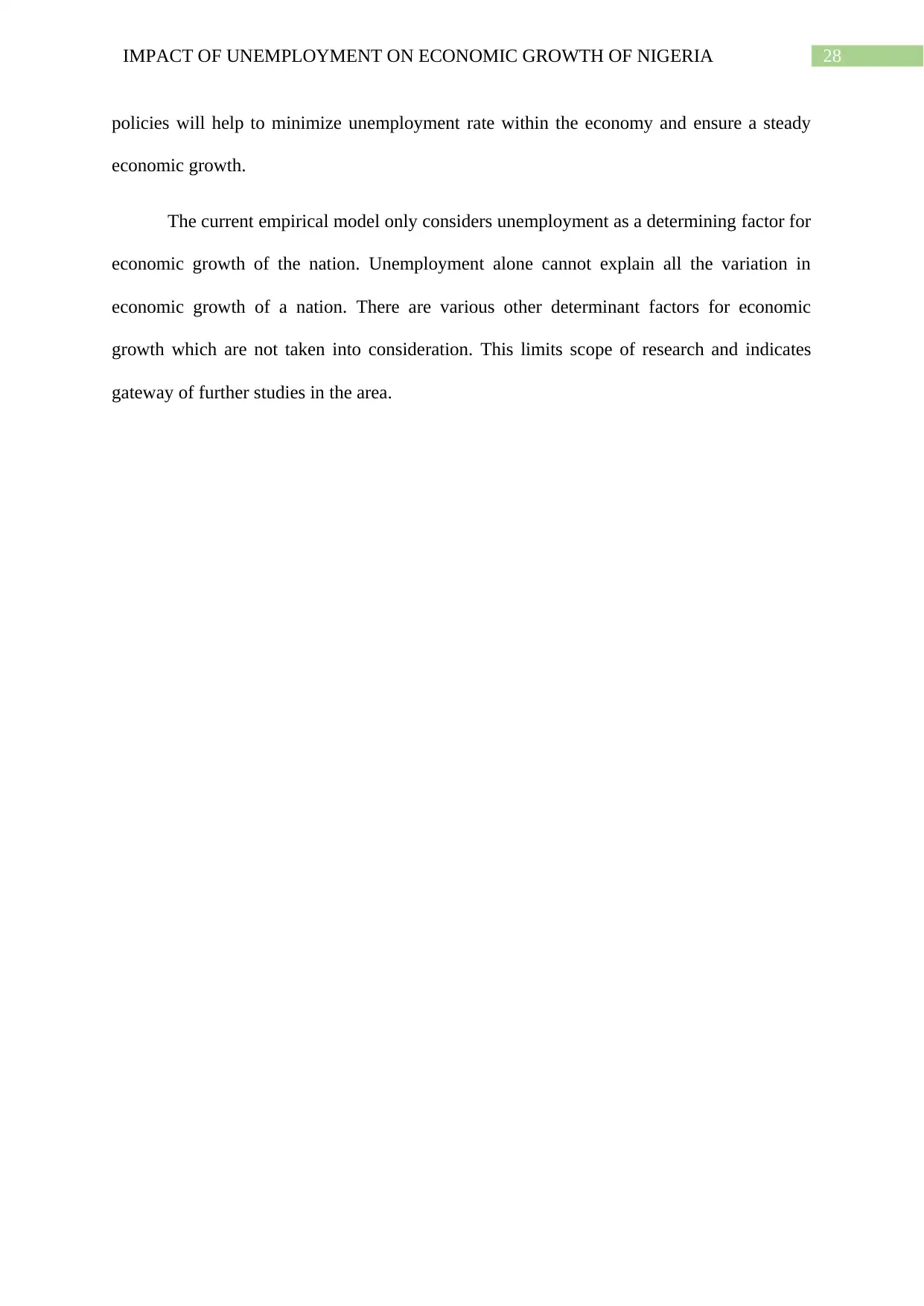
28IMPACT OF UNEMPLOYMENT ON ECONOMIC GROWTH OF NIGERIA
policies will help to minimize unemployment rate within the economy and ensure a steady
economic growth.
The current empirical model only considers unemployment as a determining factor for
economic growth of the nation. Unemployment alone cannot explain all the variation in
economic growth of a nation. There are various other determinant factors for economic
growth which are not taken into consideration. This limits scope of research and indicates
gateway of further studies in the area.
policies will help to minimize unemployment rate within the economy and ensure a steady
economic growth.
The current empirical model only considers unemployment as a determining factor for
economic growth of the nation. Unemployment alone cannot explain all the variation in
economic growth of a nation. There are various other determinant factors for economic
growth which are not taken into consideration. This limits scope of research and indicates
gateway of further studies in the area.
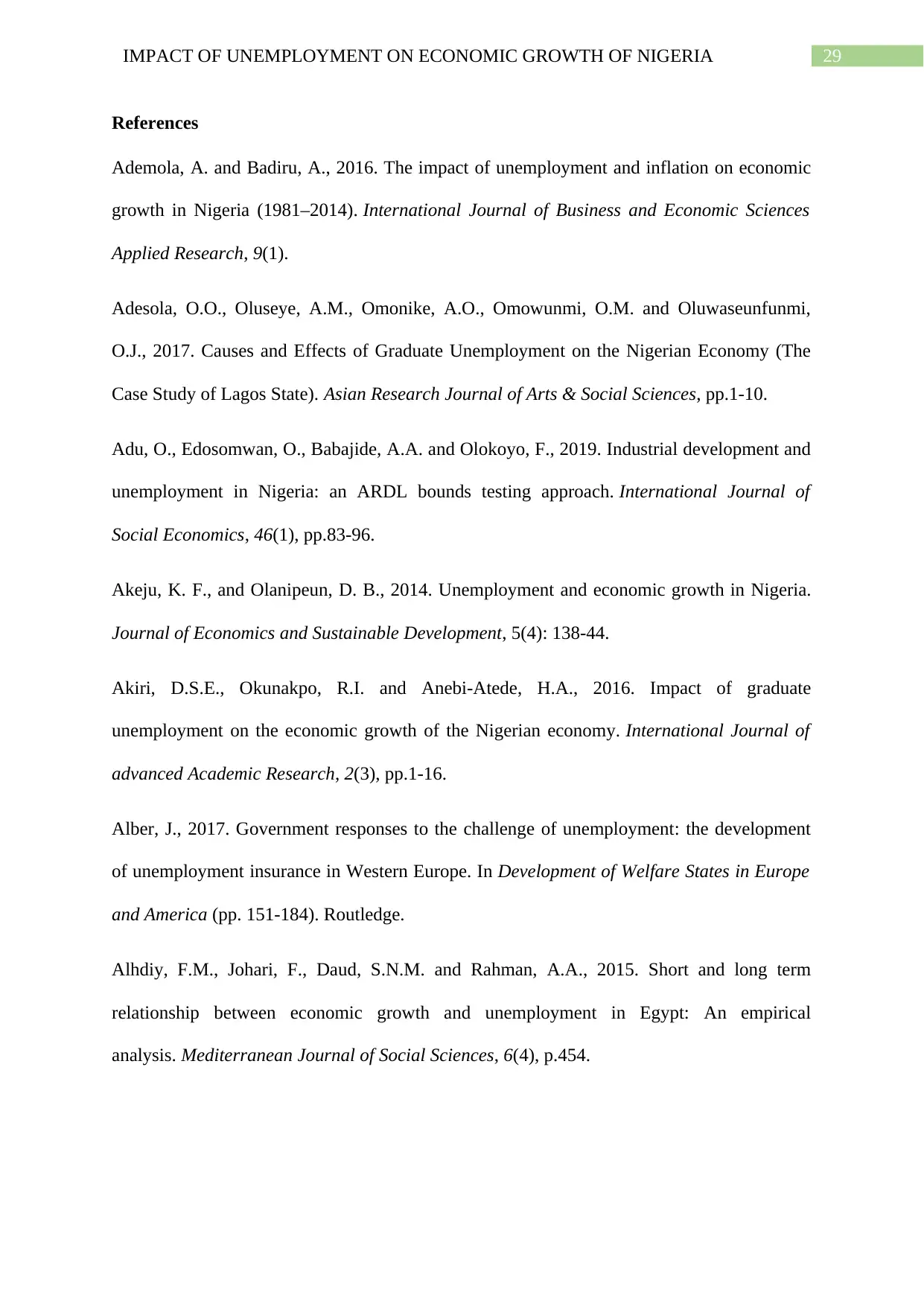
29IMPACT OF UNEMPLOYMENT ON ECONOMIC GROWTH OF NIGERIA
References
Ademola, A. and Badiru, A., 2016. The impact of unemployment and inflation on economic
growth in Nigeria (1981–2014). International Journal of Business and Economic Sciences
Applied Research, 9(1).
Adesola, O.O., Oluseye, A.M., Omonike, A.O., Omowunmi, O.M. and Oluwaseunfunmi,
O.J., 2017. Causes and Effects of Graduate Unemployment on the Nigerian Economy (The
Case Study of Lagos State). Asian Research Journal of Arts & Social Sciences, pp.1-10.
Adu, O., Edosomwan, O., Babajide, A.A. and Olokoyo, F., 2019. Industrial development and
unemployment in Nigeria: an ARDL bounds testing approach. International Journal of
Social Economics, 46(1), pp.83-96.
Akeju, K. F., and Olanipeun, D. B., 2014. Unemployment and economic growth in Nigeria.
Journal of Economics and Sustainable Development, 5(4): 138-44.
Akiri, D.S.E., Okunakpo, R.I. and Anebi-Atede, H.A., 2016. Impact of graduate
unemployment on the economic growth of the Nigerian economy. International Journal of
advanced Academic Research, 2(3), pp.1-16.
Alber, J., 2017. Government responses to the challenge of unemployment: the development
of unemployment insurance in Western Europe. In Development of Welfare States in Europe
and America (pp. 151-184). Routledge.
Alhdiy, F.M., Johari, F., Daud, S.N.M. and Rahman, A.A., 2015. Short and long term
relationship between economic growth and unemployment in Egypt: An empirical
analysis. Mediterranean Journal of Social Sciences, 6(4), p.454.
References
Ademola, A. and Badiru, A., 2016. The impact of unemployment and inflation on economic
growth in Nigeria (1981–2014). International Journal of Business and Economic Sciences
Applied Research, 9(1).
Adesola, O.O., Oluseye, A.M., Omonike, A.O., Omowunmi, O.M. and Oluwaseunfunmi,
O.J., 2017. Causes and Effects of Graduate Unemployment on the Nigerian Economy (The
Case Study of Lagos State). Asian Research Journal of Arts & Social Sciences, pp.1-10.
Adu, O., Edosomwan, O., Babajide, A.A. and Olokoyo, F., 2019. Industrial development and
unemployment in Nigeria: an ARDL bounds testing approach. International Journal of
Social Economics, 46(1), pp.83-96.
Akeju, K. F., and Olanipeun, D. B., 2014. Unemployment and economic growth in Nigeria.
Journal of Economics and Sustainable Development, 5(4): 138-44.
Akiri, D.S.E., Okunakpo, R.I. and Anebi-Atede, H.A., 2016. Impact of graduate
unemployment on the economic growth of the Nigerian economy. International Journal of
advanced Academic Research, 2(3), pp.1-16.
Alber, J., 2017. Government responses to the challenge of unemployment: the development
of unemployment insurance in Western Europe. In Development of Welfare States in Europe
and America (pp. 151-184). Routledge.
Alhdiy, F.M., Johari, F., Daud, S.N.M. and Rahman, A.A., 2015. Short and long term
relationship between economic growth and unemployment in Egypt: An empirical
analysis. Mediterranean Journal of Social Sciences, 6(4), p.454.
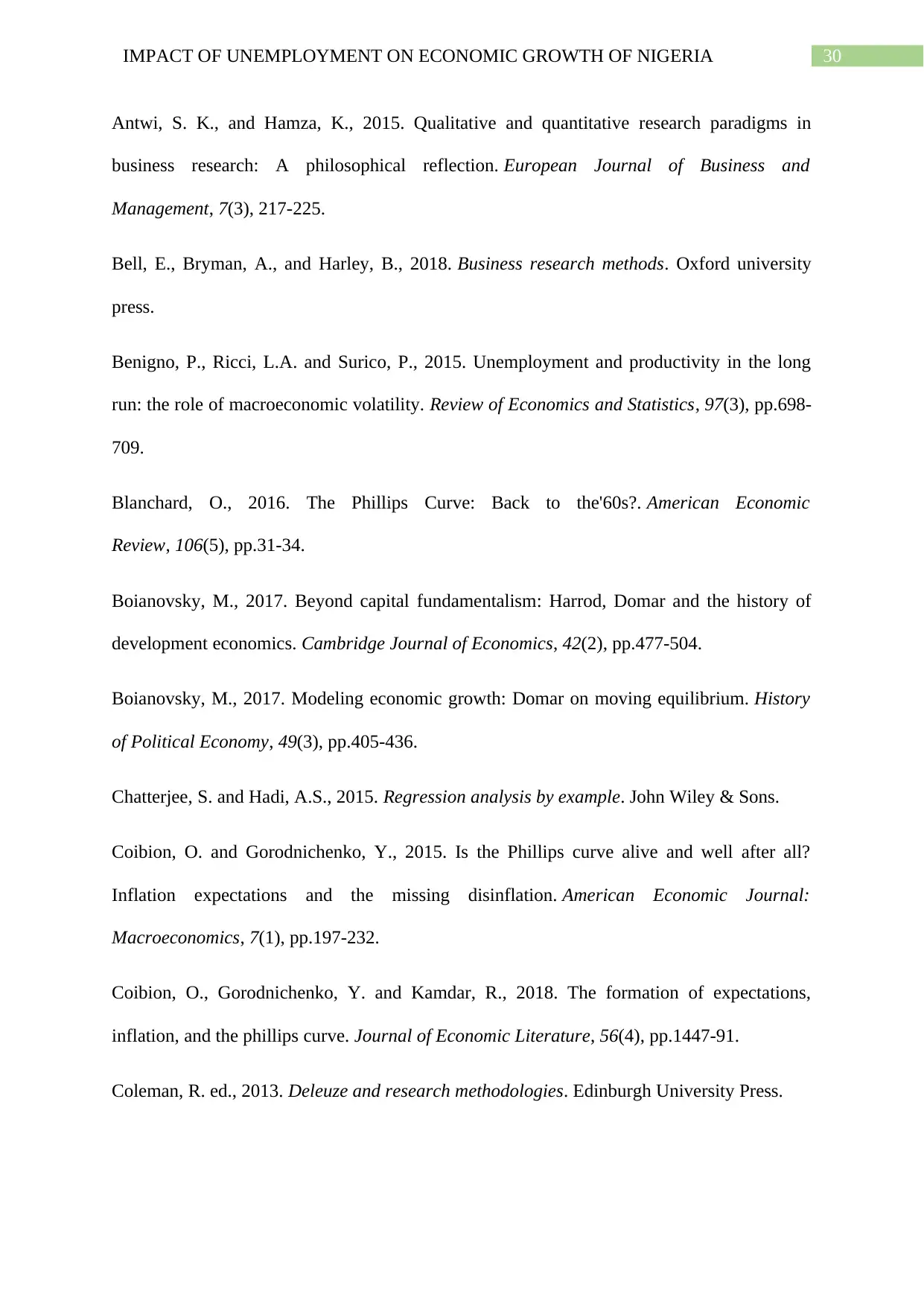
30IMPACT OF UNEMPLOYMENT ON ECONOMIC GROWTH OF NIGERIA
Antwi, S. K., and Hamza, K., 2015. Qualitative and quantitative research paradigms in
business research: A philosophical reflection. European Journal of Business and
Management, 7(3), 217-225.
Bell, E., Bryman, A., and Harley, B., 2018. Business research methods. Oxford university
press.
Benigno, P., Ricci, L.A. and Surico, P., 2015. Unemployment and productivity in the long
run: the role of macroeconomic volatility. Review of Economics and Statistics, 97(3), pp.698-
709.
Blanchard, O., 2016. The Phillips Curve: Back to the'60s?. American Economic
Review, 106(5), pp.31-34.
Boianovsky, M., 2017. Beyond capital fundamentalism: Harrod, Domar and the history of
development economics. Cambridge Journal of Economics, 42(2), pp.477-504.
Boianovsky, M., 2017. Modeling economic growth: Domar on moving equilibrium. History
of Political Economy, 49(3), pp.405-436.
Chatterjee, S. and Hadi, A.S., 2015. Regression analysis by example. John Wiley & Sons.
Coibion, O. and Gorodnichenko, Y., 2015. Is the Phillips curve alive and well after all?
Inflation expectations and the missing disinflation. American Economic Journal:
Macroeconomics, 7(1), pp.197-232.
Coibion, O., Gorodnichenko, Y. and Kamdar, R., 2018. The formation of expectations,
inflation, and the phillips curve. Journal of Economic Literature, 56(4), pp.1447-91.
Coleman, R. ed., 2013. Deleuze and research methodologies. Edinburgh University Press.
Antwi, S. K., and Hamza, K., 2015. Qualitative and quantitative research paradigms in
business research: A philosophical reflection. European Journal of Business and
Management, 7(3), 217-225.
Bell, E., Bryman, A., and Harley, B., 2018. Business research methods. Oxford university
press.
Benigno, P., Ricci, L.A. and Surico, P., 2015. Unemployment and productivity in the long
run: the role of macroeconomic volatility. Review of Economics and Statistics, 97(3), pp.698-
709.
Blanchard, O., 2016. The Phillips Curve: Back to the'60s?. American Economic
Review, 106(5), pp.31-34.
Boianovsky, M., 2017. Beyond capital fundamentalism: Harrod, Domar and the history of
development economics. Cambridge Journal of Economics, 42(2), pp.477-504.
Boianovsky, M., 2017. Modeling economic growth: Domar on moving equilibrium. History
of Political Economy, 49(3), pp.405-436.
Chatterjee, S. and Hadi, A.S., 2015. Regression analysis by example. John Wiley & Sons.
Coibion, O. and Gorodnichenko, Y., 2015. Is the Phillips curve alive and well after all?
Inflation expectations and the missing disinflation. American Economic Journal:
Macroeconomics, 7(1), pp.197-232.
Coibion, O., Gorodnichenko, Y. and Kamdar, R., 2018. The formation of expectations,
inflation, and the phillips curve. Journal of Economic Literature, 56(4), pp.1447-91.
Coleman, R. ed., 2013. Deleuze and research methodologies. Edinburgh University Press.
Paraphrase This Document
Need a fresh take? Get an instant paraphrase of this document with our AI Paraphraser

31IMPACT OF UNEMPLOYMENT ON ECONOMIC GROWTH OF NIGERIA
De Neve, J.E., Ward, G., De Keulenaer, F., Van Landeghem, B., Kavetsos, G. and Norton,
M.I., 2018. The asymmetric experience of positive and negative economic growth: Global
evidence using subjective well-being data. Review of Economics and Statistics, 100(2),
pp.362-375.
Eltis, W., 2016. Harrod–Domar Growth Model. The New Palgrave Dictionary of Economics,
pp.1-5.
Fox, J., 2015. Applied regression analysis and generalized linear models. Sage Publications.
Giugni, M., Berclaz, M. and Füglister, K., 2016. Welfare states, labour markets, and the
political opportunities for collective action in the field of unemployment: A theoretical
framework. In The Politics of Unemployment in Europe (pp. 147-164). Routledge.
Hair Jr, J.F., Wolfinbarger, M., Money, A.H., Samouel, P. and Page, M.J., 2015. Essentials
of business research methods. Routledge.
Hairault, J.O., Langot, F. and Zylberberg, A., 2015. Equilibrium unemployment and
retirement. European Economic Review, 79, pp.37-58.
Johnston, A., 2014. Rigour in research: theory in the research approach. European Business
Review, 26(3), pp.206-217.
Kareem, R.O., 2015. Employment level and economic growth of Nigeria. Journal of
Sustainable Development Studies, 8(1).
Kumar, R., 2019. Research methodology: A step-by-step guide for beginners. Sage
Publications Limited.
Llopis, J.A.S., Millán, J.M., Baptista, R., Burke, A., Parker, S.C. and Thurik, R., 2015. Good
times, bad times: entrepreneurship and the business cycle. International Entrepreneurship
and Management Journal, 11(2), pp.243-251.
De Neve, J.E., Ward, G., De Keulenaer, F., Van Landeghem, B., Kavetsos, G. and Norton,
M.I., 2018. The asymmetric experience of positive and negative economic growth: Global
evidence using subjective well-being data. Review of Economics and Statistics, 100(2),
pp.362-375.
Eltis, W., 2016. Harrod–Domar Growth Model. The New Palgrave Dictionary of Economics,
pp.1-5.
Fox, J., 2015. Applied regression analysis and generalized linear models. Sage Publications.
Giugni, M., Berclaz, M. and Füglister, K., 2016. Welfare states, labour markets, and the
political opportunities for collective action in the field of unemployment: A theoretical
framework. In The Politics of Unemployment in Europe (pp. 147-164). Routledge.
Hair Jr, J.F., Wolfinbarger, M., Money, A.H., Samouel, P. and Page, M.J., 2015. Essentials
of business research methods. Routledge.
Hairault, J.O., Langot, F. and Zylberberg, A., 2015. Equilibrium unemployment and
retirement. European Economic Review, 79, pp.37-58.
Johnston, A., 2014. Rigour in research: theory in the research approach. European Business
Review, 26(3), pp.206-217.
Kareem, R.O., 2015. Employment level and economic growth of Nigeria. Journal of
Sustainable Development Studies, 8(1).
Kumar, R., 2019. Research methodology: A step-by-step guide for beginners. Sage
Publications Limited.
Llopis, J.A.S., Millán, J.M., Baptista, R., Burke, A., Parker, S.C. and Thurik, R., 2015. Good
times, bad times: entrepreneurship and the business cycle. International Entrepreneurship
and Management Journal, 11(2), pp.243-251.

32IMPACT OF UNEMPLOYMENT ON ECONOMIC GROWTH OF NIGERIA
McCombie, J. and Thirlwall, A.P., 2016. Economic growth and the balance-of-payments
constraint. Springer.
Michael, E.O., Emeka, A. and Emmanuel, E.N., 2016. The Relationship between
Unemployment and Economic Growth in Nigeria: Granger Causality Approach. Research
Journal of Financial and Accounting, 7(24), pp.153-162.
Oduwole, T.A., 2015. Youth unemployment and poverty in Nigeria. International Journal of
Sociology and Anthropology Research, 1(2), pp.23-39.
Okoye, A.C., 2017. Entrepreneurship education: A panacea for graduate unemployment in
Nigeria. Online Journal of Arts, Management & Social Sciences, 2(1).
Olotu, A., Salami, R. and Akeremale, I., 2015. Poverty and rate of unemployment in
Nigeria. Ijm, 2(1), pp.1-2.
Orji, A., Orji-Anthony, I. and Okafor, J., 2015. Inflation and unemployment nexus in Nigeria:
Another test of the Phillips curve. Asian Economic and Financial Review, 5(5), pp.766-778.
Rees, D.G., 2018. Essential statistics. Chapman and Hall/CRC.
Schroeder, L.D., Sjoquist, D.L. and Stephan, P.E., 2016. Understanding regression analysis:
An introductory guide (Vol. 57). Sage Publications.
Seth, A., John, M.A. and Dalhatu, A.Y., 2018. The Impact of Unemployment on Economic
Growth in Nigeria: An Application of Autoregressive Distributed Lag (ARDL) Bound
Testing. Sumerianz Journal of Business Management and Marketing, 1(2), pp.37-46.
Solow, R.M., 2016. Resources and economic growth. The American Economist, 61(1), pp.52-
60.
McCombie, J. and Thirlwall, A.P., 2016. Economic growth and the balance-of-payments
constraint. Springer.
Michael, E.O., Emeka, A. and Emmanuel, E.N., 2016. The Relationship between
Unemployment and Economic Growth in Nigeria: Granger Causality Approach. Research
Journal of Financial and Accounting, 7(24), pp.153-162.
Oduwole, T.A., 2015. Youth unemployment and poverty in Nigeria. International Journal of
Sociology and Anthropology Research, 1(2), pp.23-39.
Okoye, A.C., 2017. Entrepreneurship education: A panacea for graduate unemployment in
Nigeria. Online Journal of Arts, Management & Social Sciences, 2(1).
Olotu, A., Salami, R. and Akeremale, I., 2015. Poverty and rate of unemployment in
Nigeria. Ijm, 2(1), pp.1-2.
Orji, A., Orji-Anthony, I. and Okafor, J., 2015. Inflation and unemployment nexus in Nigeria:
Another test of the Phillips curve. Asian Economic and Financial Review, 5(5), pp.766-778.
Rees, D.G., 2018. Essential statistics. Chapman and Hall/CRC.
Schroeder, L.D., Sjoquist, D.L. and Stephan, P.E., 2016. Understanding regression analysis:
An introductory guide (Vol. 57). Sage Publications.
Seth, A., John, M.A. and Dalhatu, A.Y., 2018. The Impact of Unemployment on Economic
Growth in Nigeria: An Application of Autoregressive Distributed Lag (ARDL) Bound
Testing. Sumerianz Journal of Business Management and Marketing, 1(2), pp.37-46.
Solow, R.M., 2016. Resources and economic growth. The American Economist, 61(1), pp.52-
60.

33IMPACT OF UNEMPLOYMENT ON ECONOMIC GROWTH OF NIGERIA
Uz, Z.Q., Donghui, Z. and Imran, M., 2016. Unemployment and Economic Growth of
European Union: a Panel Data Analysis. European Journal of Economic Studies, (1), pp.292-
298.
Yelwa, M., David, O.O. and Awe, E.O., 2015. Analysis of the relationship between inflation,
unemployment and economic growth in Nigeria: 1987-2012. Applied Economics and
Finance, 2(3), pp.102-109.
Zhang, W.B., 2018. Economic Growth Theory: Capital, Knowledge, and Economic Stuctures.
Routledge.
Uz, Z.Q., Donghui, Z. and Imran, M., 2016. Unemployment and Economic Growth of
European Union: a Panel Data Analysis. European Journal of Economic Studies, (1), pp.292-
298.
Yelwa, M., David, O.O. and Awe, E.O., 2015. Analysis of the relationship between inflation,
unemployment and economic growth in Nigeria: 1987-2012. Applied Economics and
Finance, 2(3), pp.102-109.
Zhang, W.B., 2018. Economic Growth Theory: Capital, Knowledge, and Economic Stuctures.
Routledge.
1 out of 34
Related Documents
Your All-in-One AI-Powered Toolkit for Academic Success.
+13062052269
info@desklib.com
Available 24*7 on WhatsApp / Email
![[object Object]](/_next/static/media/star-bottom.7253800d.svg)
Unlock your academic potential
© 2024 | Zucol Services PVT LTD | All rights reserved.





